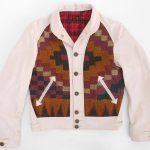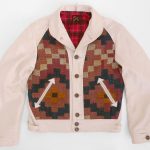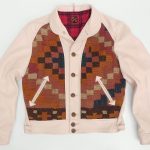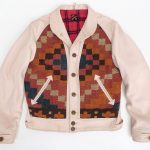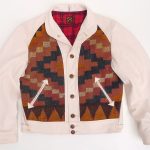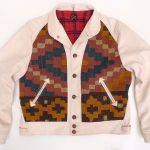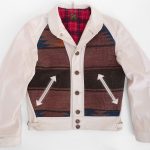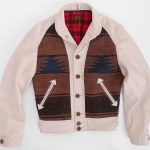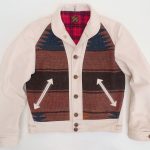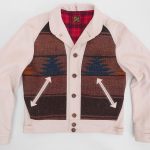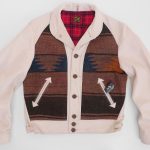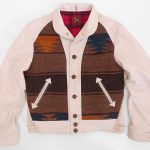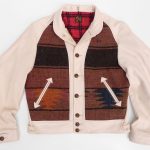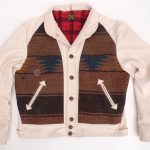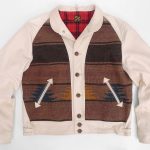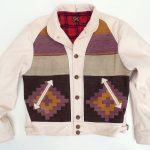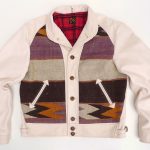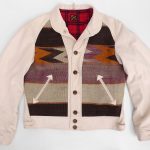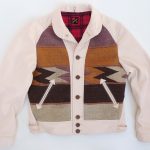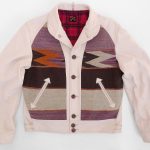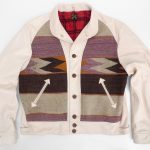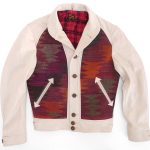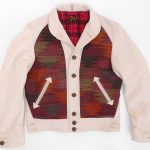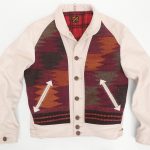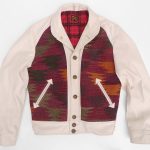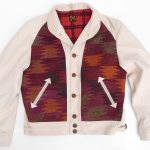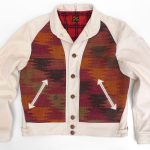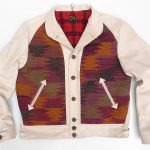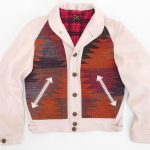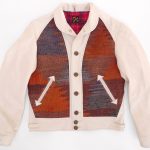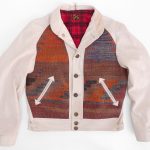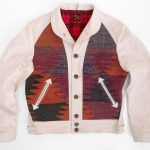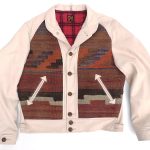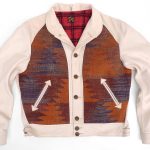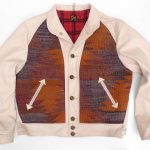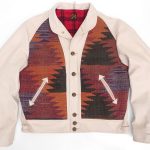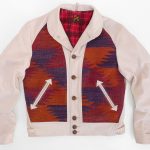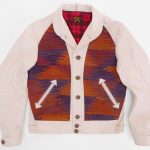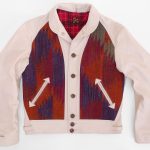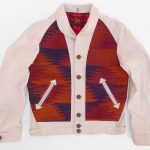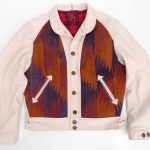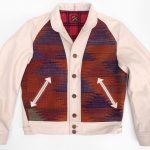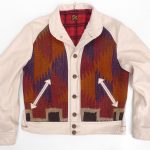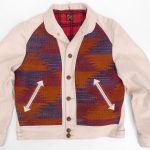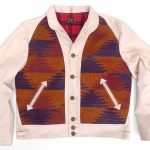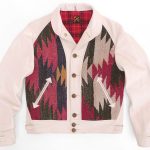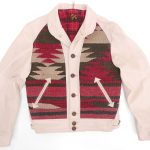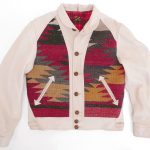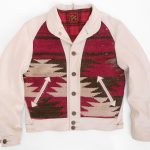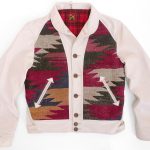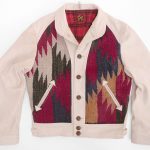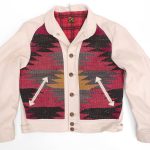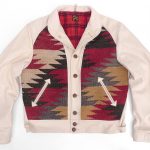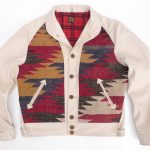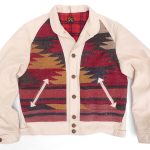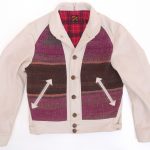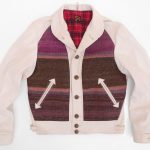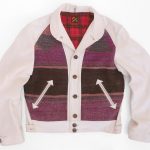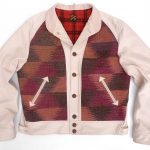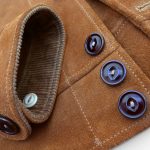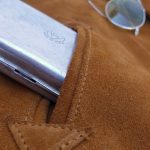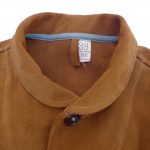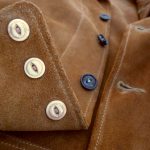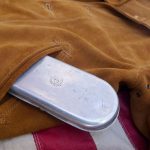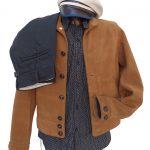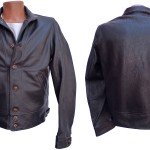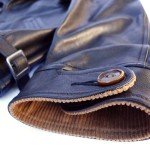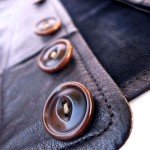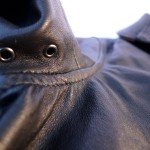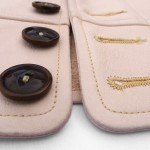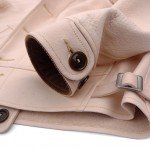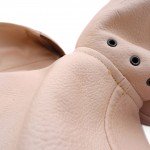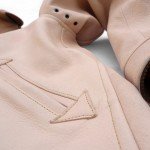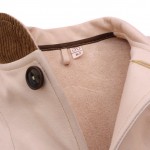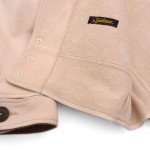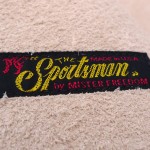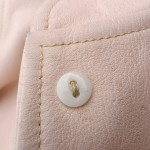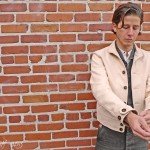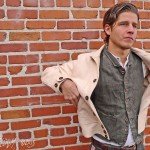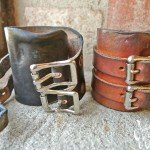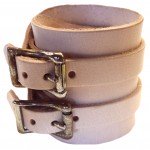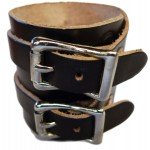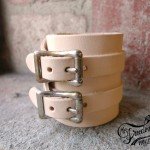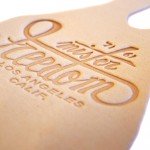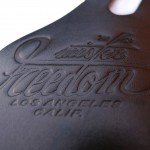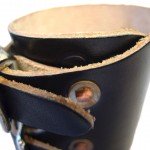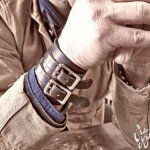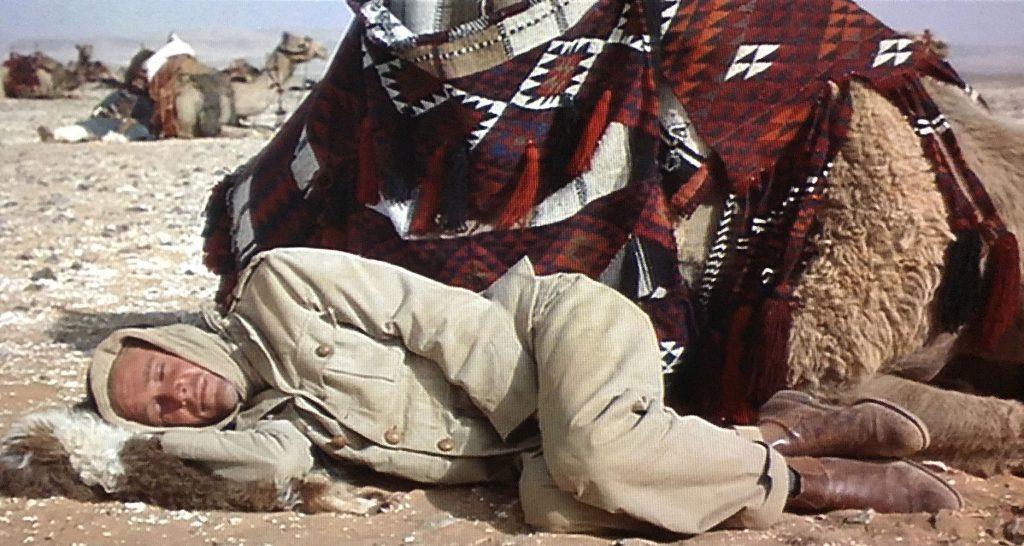   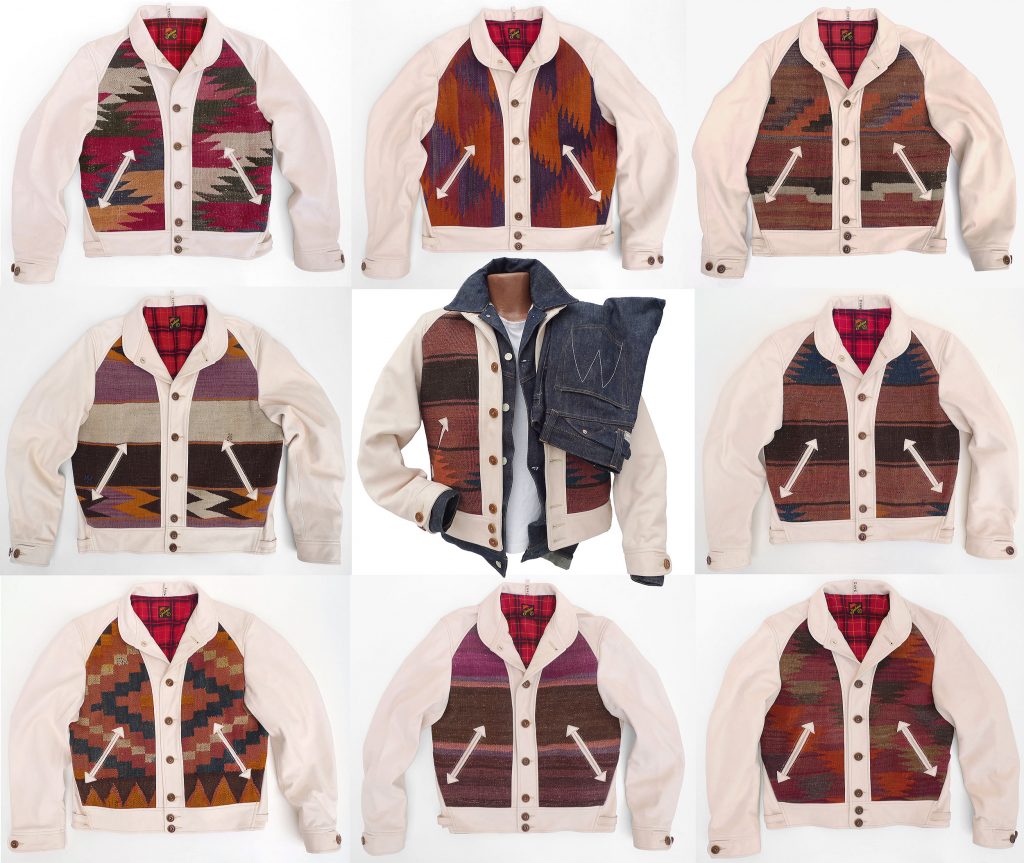

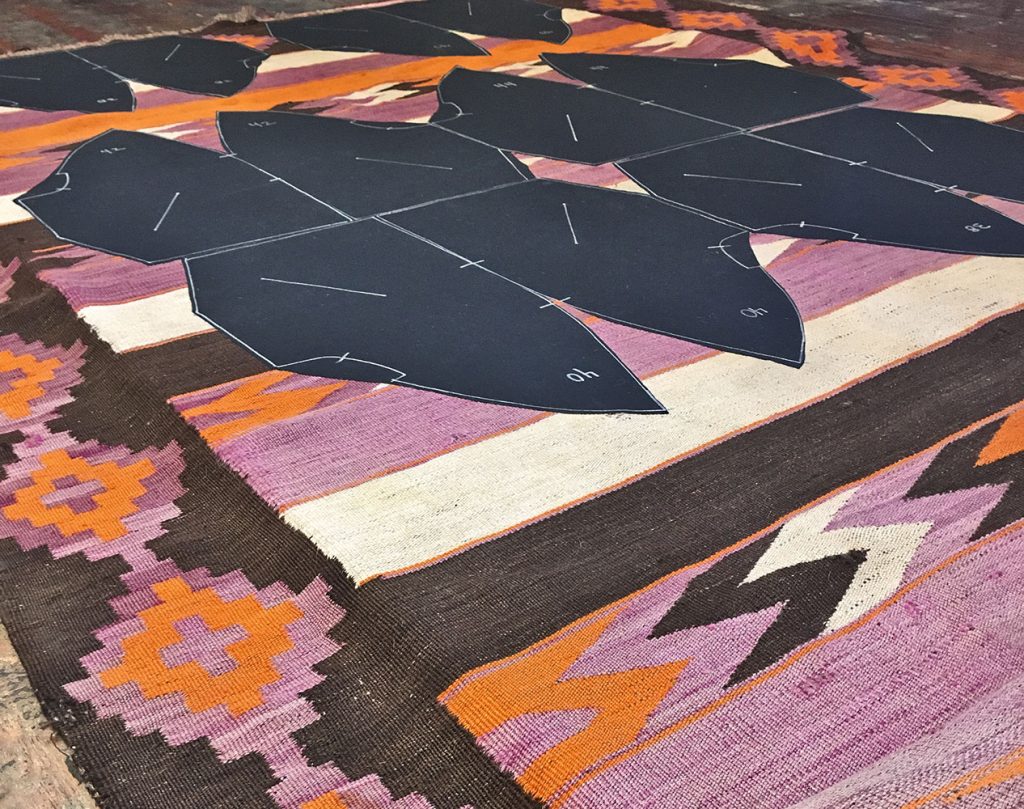
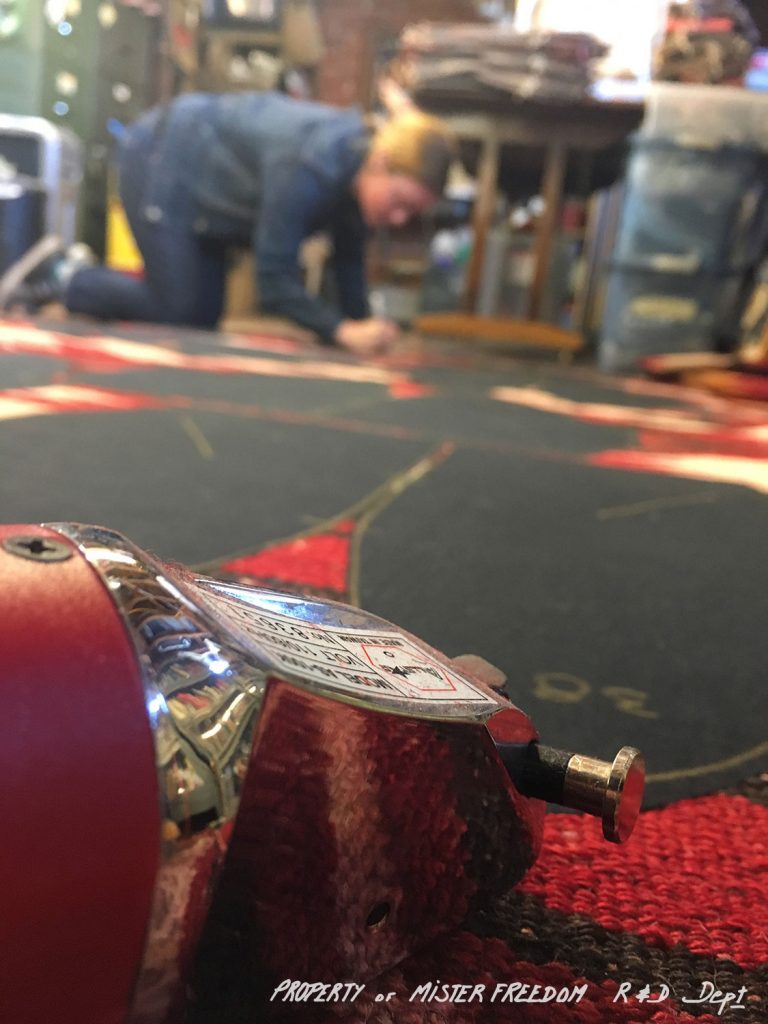
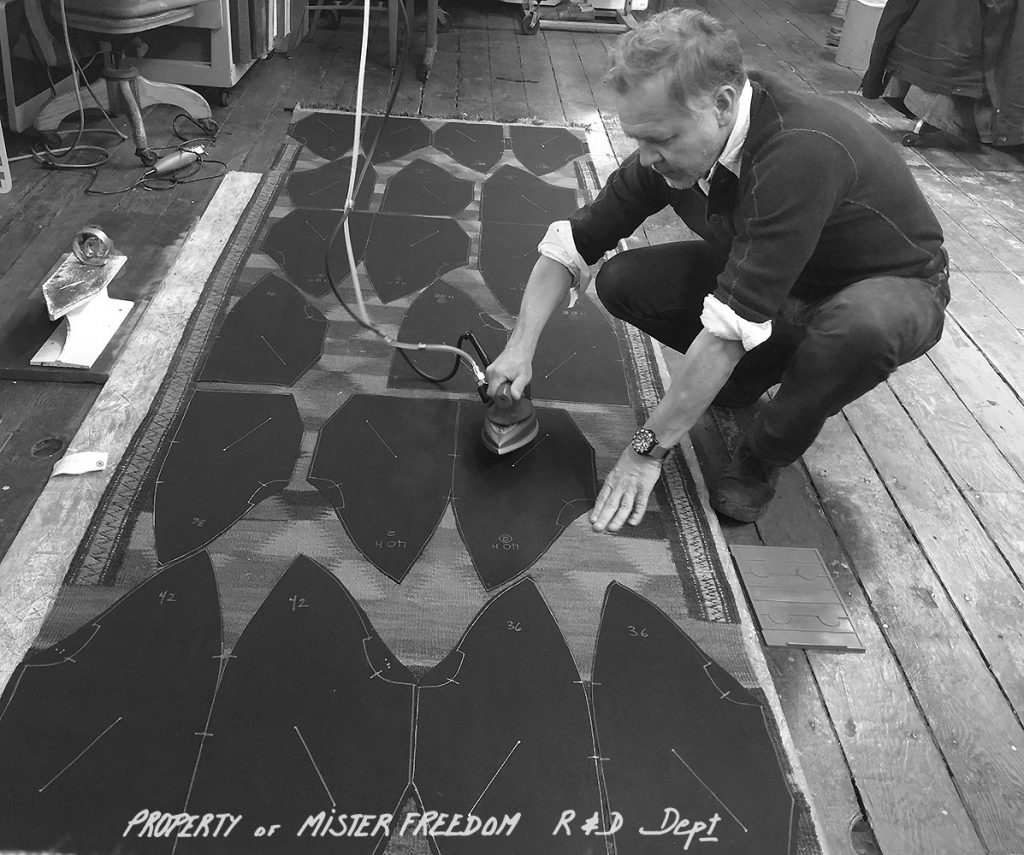
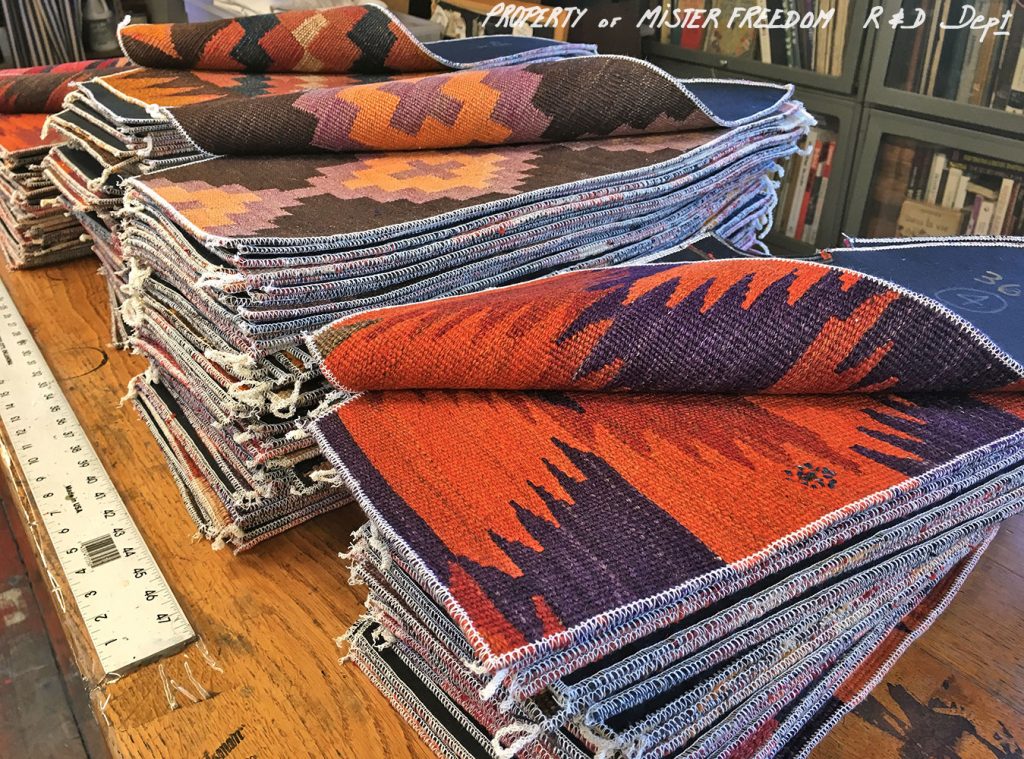 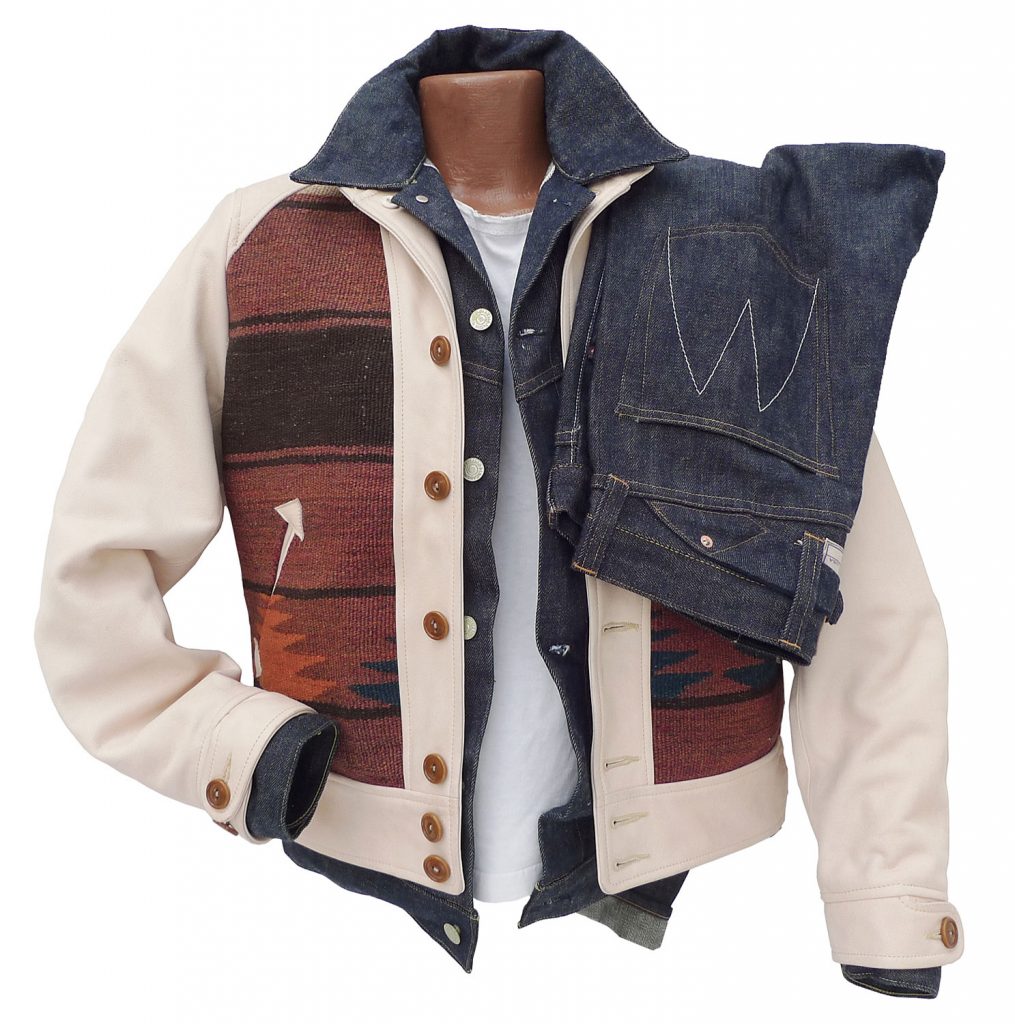
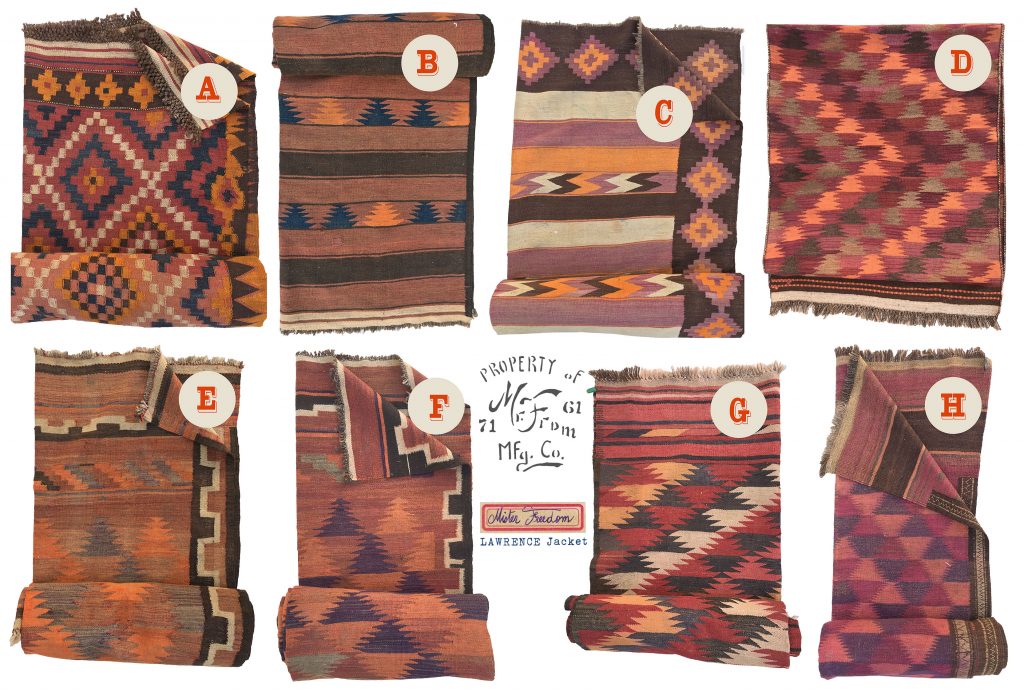
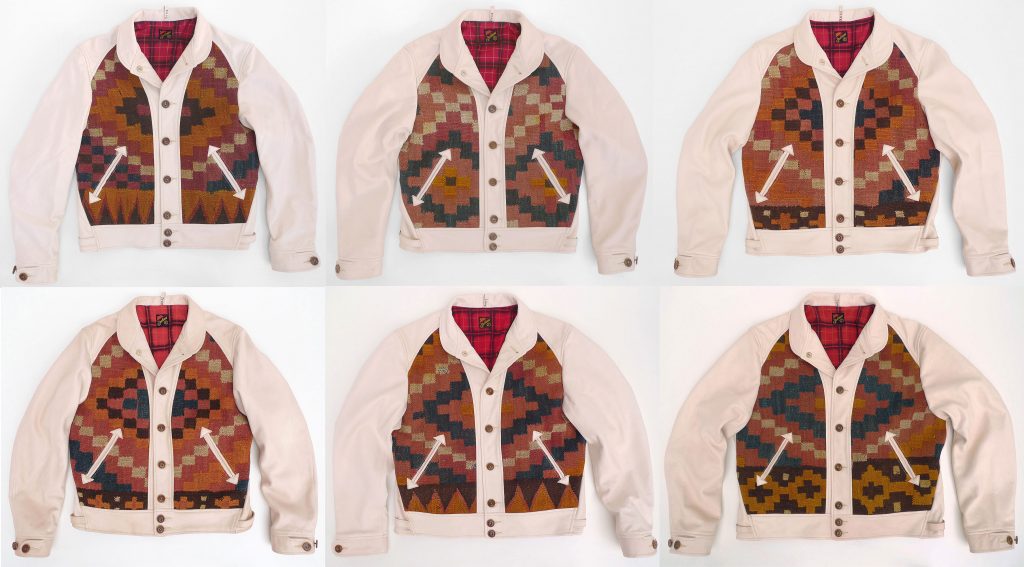 Mister Freedom® “Lawrence” Jacket, Caravan A. 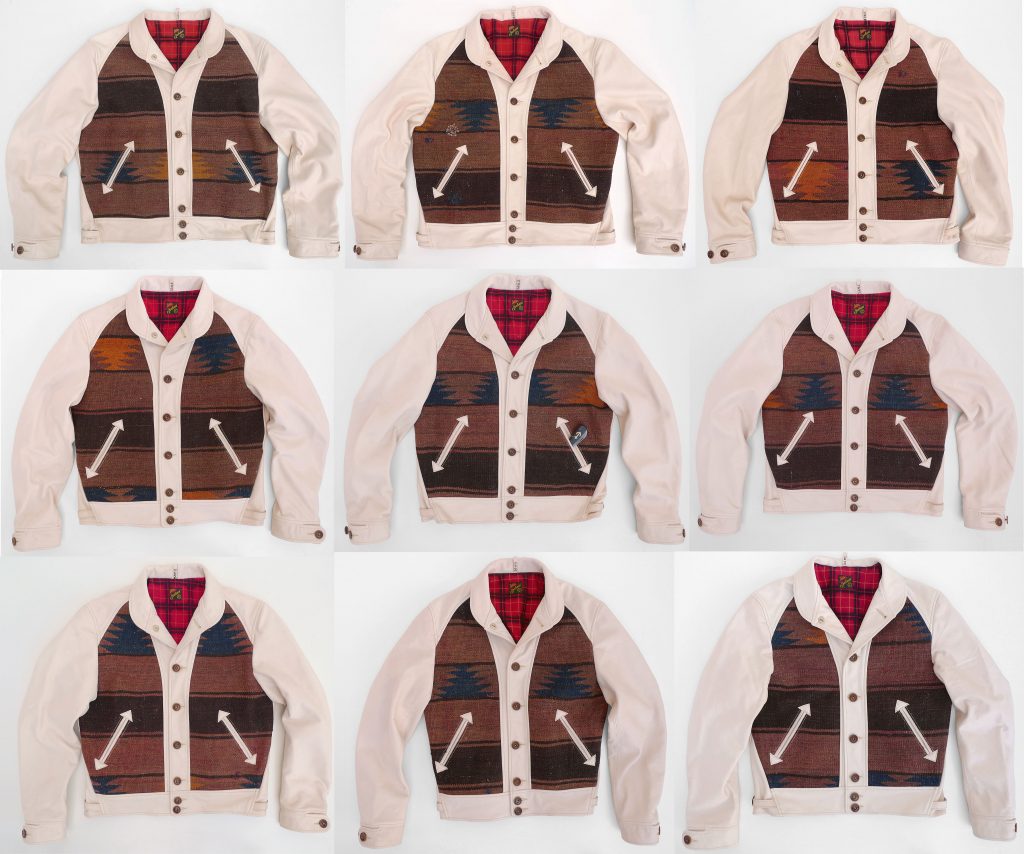 Mister Freedom® “Lawrence” Jacket, Caravan B. 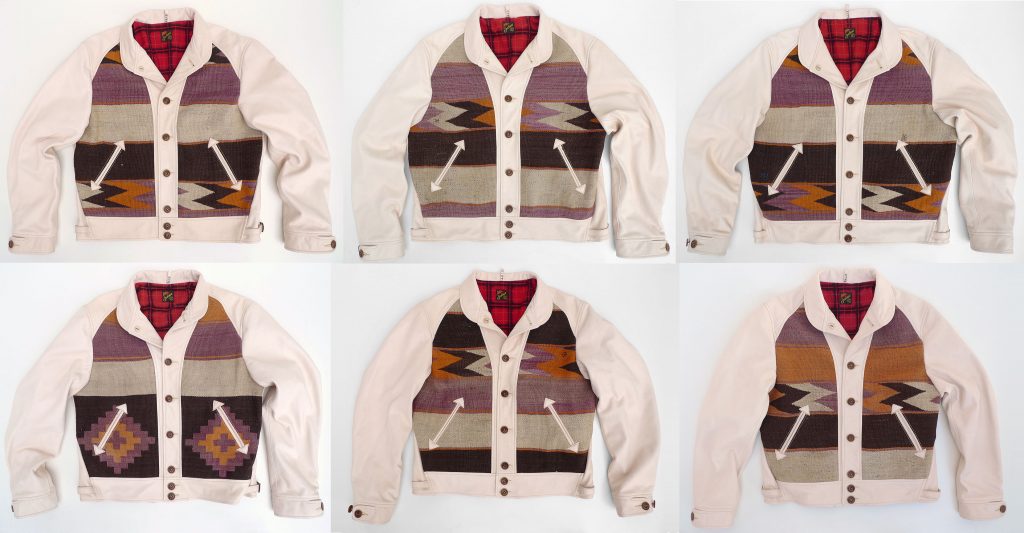 Mister Freedom® “Lawrence” Jacket, Caravan C. 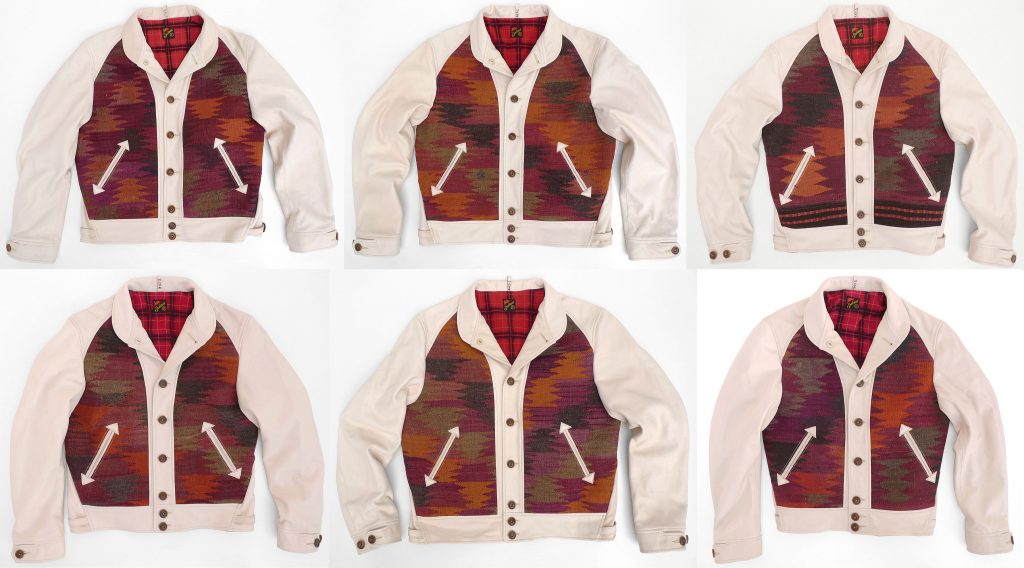 Mister Freedom® “Lawrence” Jacket, Caravan D. 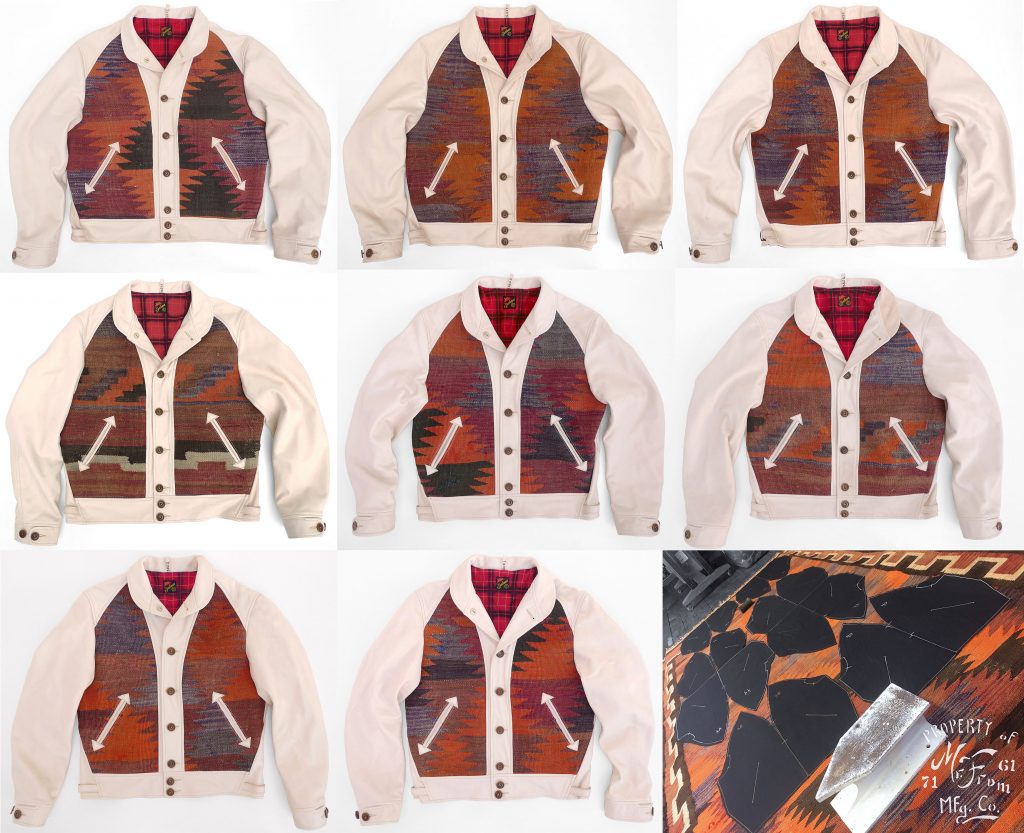 Mister Freedom® “Lawrence” Jacket, Caravan E. 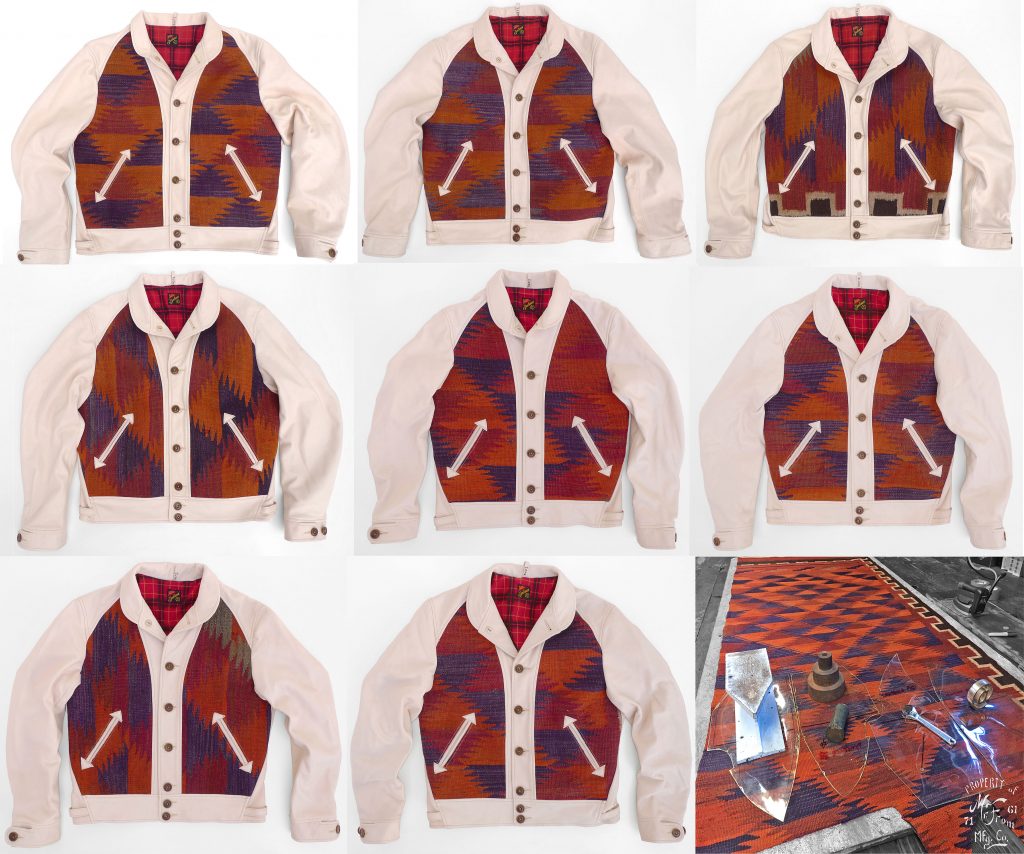 Mister Freedom® “Lawrence” Jacket, Caravan F. 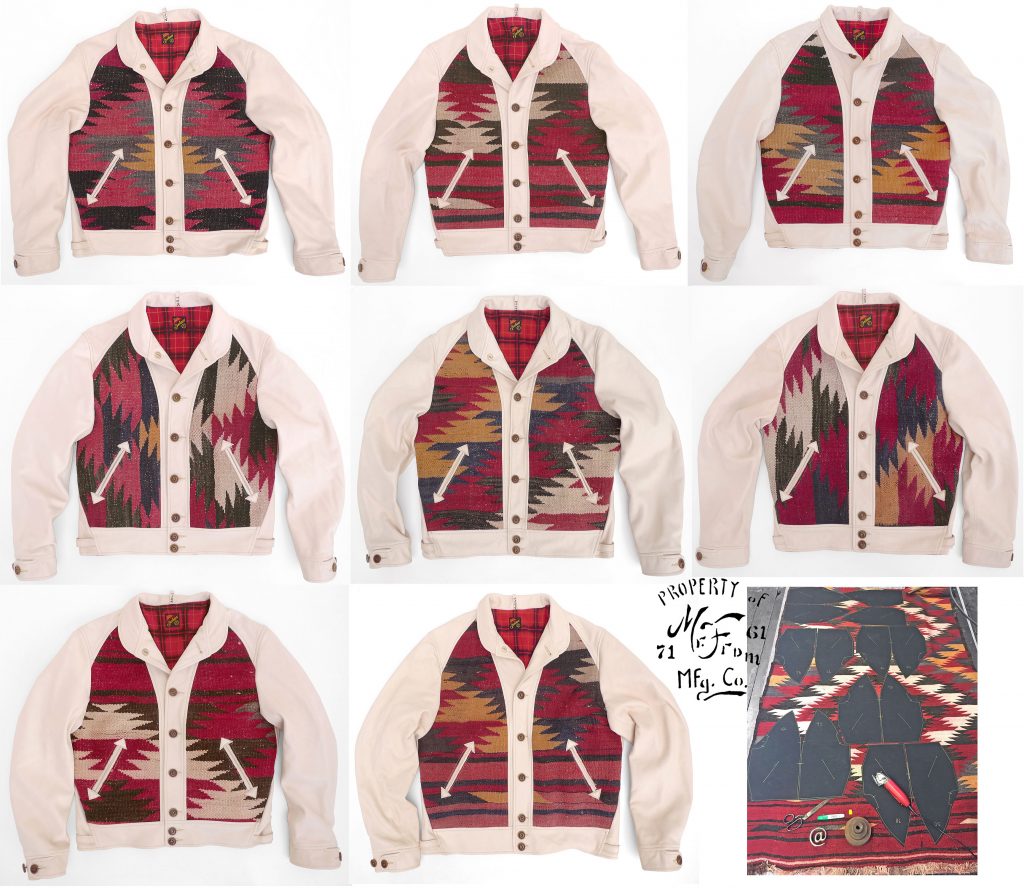 Mister Freedom® “Lawrence” Jacket, Caravan G. 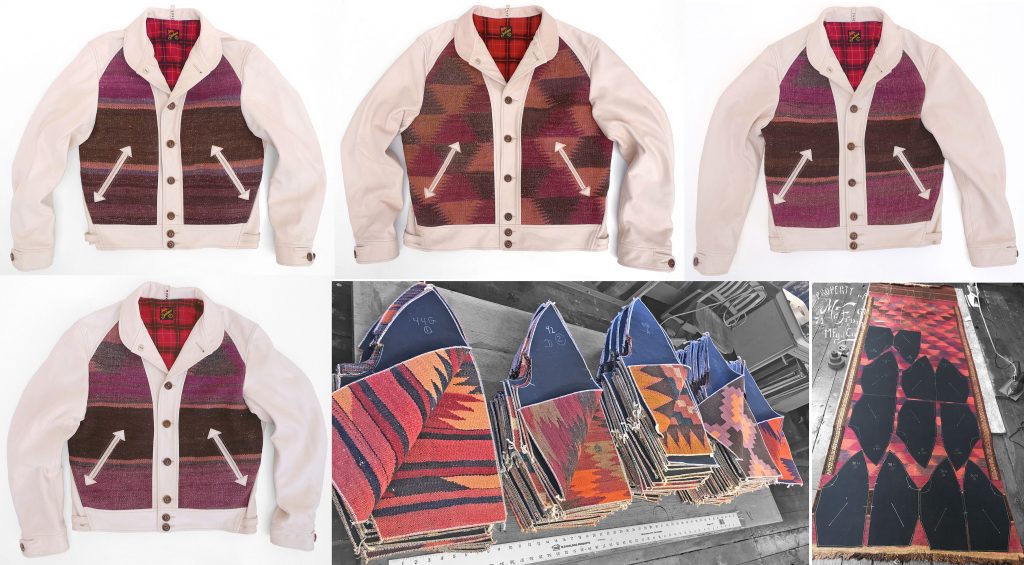 Mister Freedom® “Lawrence” Jacket, Caravan H.
Mister Freedom® “LAWRENCE” Jacket, up-cycled antique Kilim rugs/blankets.
FW2018 Limited Edition.
Made in USA.
For this glorious season, we concocted a special one-of-a-kind rendition of the Mister Freedom® Baloo jacket, the furry little number we had introduced last Fall. The Baloo, our interpretation of the popular 1930’s “grizzly” type leather coats, and a bear necessity for the classic leather jacket connoisseur today, got back to the drafting table for a new wacky spin à la MF®.
We are calling this Fall 2018 garment the “LAWRENCE”, a reference to the wild Arabian adventures of famed British archeologist, camel-riding diplomat, khanjar-toting gentleman, gone-native Army Captain, Thomas Edward Lawrence.
Having watched Lawrence of Arabia‘s exciting silver screen saga one-time-too-many (cue-in Maurice Jarre’s haunting score), someone at the office had the balmy idea of spicing-up the ol’ MF® Baloo pattern with a dash of exotic oriental flavors!
Taking the usual MF® liberties with geography, cultural authenticity, historical accuracy and common sense, it was decided to blend antique oriental textiles with our classic leather jacket. By incorporating into our USA-made Baloo pattern a mixed bag of vintage rugs or blankets out of the “Rug Belt” (think bygone Persian and Ottoman Empires, the Middle East and South Asia), our plan was to deliver a somewhat plausible local souvenir that ‘Aurens could have brought home from his tumultuous epic travels, a custom-made jacket to go ride his Brough Superior around, Bedouin-style, back in the peaceful English countryside.
Now, this one is for the social media… The following exchange allegedly took place on a distant shore of the Red Sea, sometime in 1917, as reported by a reliable source claiming to be present at the time. This bizarre bazaar encounter is not a well-documented episode, and although its accuracy will fiercely be debated on 4chan in the coming years, historians we consulted have all confirmed it with an eye roll. So, do quote us on it, and remember where you heard it here first. This is how it was relayed to the MF® Editorial Dept., verbatim:
Souk merchant: “Yalla, English! I have nice jacket for you, souvenir from Aqaba! Has your name written on it, wallah!”
T.E. Lawrence: “Nothing is written, my good lad. Oh… wait… dude! That’s one funky fresh jacket!!”
Souk merchant: “Shukran ‘Aurens, I knew you’d dig it, habib! Toldja, mektoub! Now, paper or plastic?”
(?)
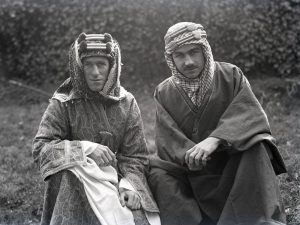 “Yep, that’s pretty much how it happened.” Words unpronounced by T.E. Lawrence & Lowell Thomas, London, 1918 (Image ©Marist College) Above photo of “T.E. Lawrence & Lowell Thomas sit in London session portraits” 1918 courtesy of ©Marist Archives, in accurate historical context here.
In regards to style, the following statement might make anthropology textile experts cringe (they probably already left this page realizing we’re about to chop-off collectibles to turn them into “fashion” items anyways), but an amateur might point out visual similarity between certain Kilim traditional patterns and some of their hand-woven Native American counterparts. For the profane (that’s us), geometric symbolism such as tribal stripes, the famous Eye-Dazzler pattern, diamonds, stars, running water, or multicolor Anatolian Manastir motifs, do bring to mind works of early and contemporary Navajo or Pueblo weavers, and other skilled loom artists who contributed to the production of rugs and blankets of the American Southwest. The commun thread, we believe, is that commercially-produced traditional crafts of a specific ethnic group will inevitably evolve with outside demand, bartering, raw material and dye imports, foreign tastes and eventual cultural assimilation. Similar designs and symbols appear along trade routes, distant styles end-up overlapping, making cultural authenticity somewhat of a subjective concept with artisanal handicraft. So, expect an occasional “awesome Indian blanket jacket, dude!” comment, while sporting your MF® Lawrence.
After this colorful ouverture, and rather than sharing an uneducated opinion on current Arab affairs and oil barrel prices, here are a few highlights of our own saga with the MF® “Lawrence” production, for the insomniac few.
As often with USA-made projects we embark on, comes the moment we all look at each others at the HQ, with the same puzzling question: “Who the *%$#&* thought that was a good idea?” Even our intrepid MF® R&D Department expressed doubts during manufacturing…
First, we had to source the full grain veg-tan leather hides, all inspected one by one for grain, overall quality and feel. This is the same grade of leather we have been using since 2013 for the MF® Campus, and its Baloo successor. The hides are very light sensitive and initially almost ivory white, until exposed to natural daylight. The leather gradually sun-tans to a pinkish hue, eventually developing attractive golden tones.
Then, Hut, Hut, Hut, off we went on a hunting safari for vintage rugs!
We found a local Ali baba’s cave, the vault of a Pakistan-born textile expert, a gentleman specialized in legally-imported, well-documented antique oriental rugs. Going through dozens and dozens of stacked-up specimen, we focused on flat-woven Kilim rugs of the non-pile (flat weave) and non-slit family (no “openings” in the weave.) We carefully selected candidates from the first half of the 20th Century that aesthetically and technically qualified for the project. Each rug was hand-picked for its attractive geometric motifs, vintage appeal, fine color combination, unique hand-woven imperfections, occasional period hand-repairs and overall natural patina. These are woven from wool and cotton yarns, dyed in unstable, non-colorfast natural dyes, often leading to subtle color runs. This is part of their wabi-sabi charm, and the uniqueness separates them from Ikea’s versions. The kilim expert mentioned that, back home, these rugs served as wall-hanging decoration, blankets, home carpets, camel saddle covers…
Considering the latter, we took our loot to a professional cleaning facility specialized in antique rugs, an impressive old-school operation established in Los Angeles in 1926, a recommendation from our friend Channon at In The Field. We had each rug thoroughly hand-brushed, hand-washed and sun-dried, without the use of machines, quite a costly procedure, almost doubling the cost of each vintage piece!
Came the time to unroll the freshly-clean rugs back in our atelier, and figure-out how to turn them into front panels of jackets… To strategically cut according to each rug design, while trying to envision each finished jacket with well-balanced panels, we thought of making our pattern paper out of clear PVC.
It soon hit us that there is nothing remotely symmetrical in a nomadic tribal rug, hand-woven on an horizontal floor loom, somewhere in a remote mountainous region of Pakistan, some 80 years ago. Eye-balling seems to be the golden rule in metrology for the Rug Belt artisans.
After a few hours of deliberation, positioning and repositioning the pattern markers, we traced panels on each rug, combining sizes and grain direction. We then painstakingly fused the panels with high-quality woven cotton fusing, using an industrial steam iron. We, of course, chose to do this during the hottest months of summer, to fully embrace the benefits of facial steaming.
Each panel was then cut using electric shears, somewhat of a liberating experience, and carefully overlocked to avoid later fraying of the edges.
After completing this portion of the hands-on production, we resumed our water-skiing activities and badminton tournaments. The MF® atelier’s contribution was temporarily over! The jackets themselves, however, still had to get made…
We happily passed the hot potato to a local facility, who, in-turn, couldn’t wait to throw it back at us. The factory’s expert craftsmen had never worked on such a “fun” project, involving new leather and eclectic vintage textiles. Most places would have turned us down, so we are indebted to our small manufacturing source for accepting the challenge. After a few months of intricate and complicated assembly work, production management headaches and anxious back-and-forth, our Lawrence Jackets were ready! Ready, that is, for the final touch back at the MF® HQ: hand-sewing hundreds of corozo double buttons, which gets old after about five.
We are, many months later, proud to announce our one-of-a-kind and once-in-a-lifetime MF® “LAWRENCE” jackets! We hope you enjoy the finished product as much as we got our kicks during the manufacturing fantasia!
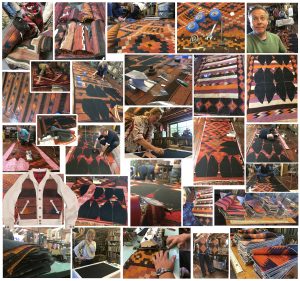 The Mister Freedom® “Lawrence” Jacket saga ©2018 As one will guess from the making-of collage, the yield (number of panels per rug), selection of sizes cut per rug, and geometric design variations per panel within each rug, all got out of control pretty quick. We had realized early-on that no-two jackets were going to be the same, making the MF® Product Photography Department quiver in anticipation of this post.
For inventory purposes, we have regrouped the MF® Lawrence jackets in eight families (called them caravans), according to the specific vintage Kilim rug they were cut from (Caravan A, B, C, D, E, F, G, or H). Not every rug yielded a full size scale, and availability of the MF® Lawrence jacket will be limited to this FW2018 batch.
DISCLAIMER:
* VEG-TAN LEATHER: The Mister Freedom® Lawrence Jacket is cut from genuine leather. We use full-grain, and not “top-grain” leather (aka corrected or buffed leather, sanded to level surface inconsistencies). No two hides are alike and each panel may feature variations in texture along with natural imperfections.
* The occasional nicks and marks on the hides we select are characteristic of pasture-raised cattle, with the implication of natural scarring from roaming and being in contact with other animals. Considering the obvious perks of outside grazing for the cattle, vs. confined indoors or in pens as required for the production of some luxury leather goods, we find these natural imperfections to be perfectly acceptable, if not a desirable trait of a Mister Freedom® leather garment. These “life” marks are inherent to full grain leather, and will blend into a natural patina when our jacket is worn, conditioned and lived-in.
* Early signs of tanning of panels may, at times, be visible on a finished garment, as we pay premium to have our leather goods produced in a pleasant, well-lit, clean and ethically-run California facility. We’ll leave the dark, un-safe, regulation-evading basements where less-fortunate workers toil, to less-regarding fast-fashion labels catering to the modern consumer’s insatiable appetite for “affordable” disposable goods. In other words, we do not consider a new jacket with partially-suntanned panels a defective garment.
* RECYCLED KILIM RUGS: The front panels feature genuine vintage kilim rugs/blankets that are about 70 to 90 years old. These can show signs of wear and natural patina, color fading and crocking, woven imperfections and unevenness, design pattern asymmetry and occasional rugged hand repairs. Due to Mister Freedom®’s background in vintage clothing, we consider these imperfections desirable. These natural flaws are inherent to up-cycling projects, such as turning antique textiles into new unique garments, still fit as wearables for next generations.
Thank you for your understanding.
The MF® LAWRENCE Jacket is designed by Mister Freedom® and manufactured in USA, from USA-sourced hides and up-cycled genuine vintage Oriental rugs of the Kilim family.
SPECS:
PATTERN:
Inspired by 1930’s “Grizzly” type leather jackets, and other vintage American sportswear and outdoor garments, and somewhat by the 1962 film “Lawrence of Arabia”.
The original MF® Lawrence jacket pattern is adapted from our MF® Baloo jacket pattern, in turn adapted from the MF® Campus jacket.
MATERIALS:
* Shell: Vegetable tanned leather, full grain cowhide, milled and supple, natural finish and color, about 2-3 Oz weight, sourced in USA.
* Front panels: Up-cycled vintage Oriental rugs of the Kilim family, with a probable provenance in Pakistan and surrounding regions.
* Lining: 100% cotton brushed flannel with a 1940’s-50’s-inspired vibrant plaid pattern, discharge-printed. Fabric milled in Japan.
DETAILS:
* Vintage 1930’s style, inspired by cossack-type and Grizzly-type panel leather jackets.
* Fully lined with a soft cotton brushed flannel featuring a vintage style discharge-printed plaid pattern.
* Front panels cut from a vintage genuine Oriental Kilim rug.
* Full single panel veg-tan leather back.
* Slash pockets with arrow-head pocket stops.
* Side gussets with adjustable side straps (NOS metal slide buckles)
* Keyhole button holes.
* Corozo ‘Cat Eyes’ wood buttons, backed by vintage-style corozo wood “cat-eyes” buttons.
* Mister Freedom® woven “Sportsman” label.
* American-sourced hides.
* Limited Edition. Each jacket is a one-of-a-kind collectible.
* Made in USA.
SIZING:
The MF® LAWRENCE Jacket is true to size. I am usually a 38 in mfsc jackets and opted for a 38 in the MF® LAWRENCE, with enough room for a lightweight layer underneath.
The fit is relatively snug, so we do not advise sizing-down on this garment if you are in-between sizes. If planning on layering with heavy cable knit wool sweaters, consider sizing up in order to be able to comfortably button-up the jacket.
Refer to sizing chart below for approximate measurements. Please consider the thickness of the leather/Kilim/lining when trying to match your chest measurements and the jacket’s measurements. If still in doubt, please contact sales@misterfreedom.com with your specifics for recommendations.
CHART
CARE:
We recommend wearing the jacket as-is. No specific initial conditioning or pre-treatment is required. Just wear and enjoy witnessing the natural ageing and patina evolution.
According to frequency of wear and exposure to the elements, some light conditioning might be applied to the sleeves after months of continuous wear, using products similar to Pecard Antique Leather Care. Be aware that conditioning will darken the leather, and should only be applied with care and expertise.
* Do not dry clean. Even professional leather cleaning facilities might not be competent on how to treat the specific LAWRENCE jacket veg-tan leather/woolen woven rug/cotton lining combo.
* Do not use heavily-oily products designed for footwear, such as neatsfoot oil.
* Do not attempt to “wash” the Kilim woven panels. Use a dry, plastic bristle brush for cleaning if needed.
* Should leather parts of your jacket get accidentally stained from normal wear, consider this a normal stage of the evolution of an outdoor garment. As often witnessed on well-worn vintage leather jackets, wear, stains and scratches will eventually blend-in into the most attractive and unique patinas.
Available NATURAL.
Sizes
36 (Small)
38 (Medium)
40 (Large)
42 (XLarge)
44 (XXLarge)
Front panel styles/patterns: regrouped in eight kilim families/caravans: A, B, C, D, E, F, G, or H.
Not every rug yielded a full size scale, and size/style/pattern availability is limited to this FW2018 batch.
Not all jackets were photographed, but each caravan grouping is representative of the available selection.
Note on inventory: Each jacket is numbered on the collar loop (example 38G1). The letter in the code does indicate the specific rug, but, due to the similarity in some of the woven designs, some jackets have been attributed to the wrong kilim rug during the numbering. For instance, the Lawrence jacket 40F3 is actually cut from Kilim D and should have been marked 40D3. Its photo file was renamed 40F3d, but the jacket itself was not re-branded on the collar loop.
Available from www.misterfreedom.com, our Los Angeles brick & mortar store, and fine retailers around the World.
Email sales@misterfreedom.com or call 323-653-2014 with any questions unanswered above.
Thank you for your support.
Christophe Loiron
Mister Freedom®
©2018
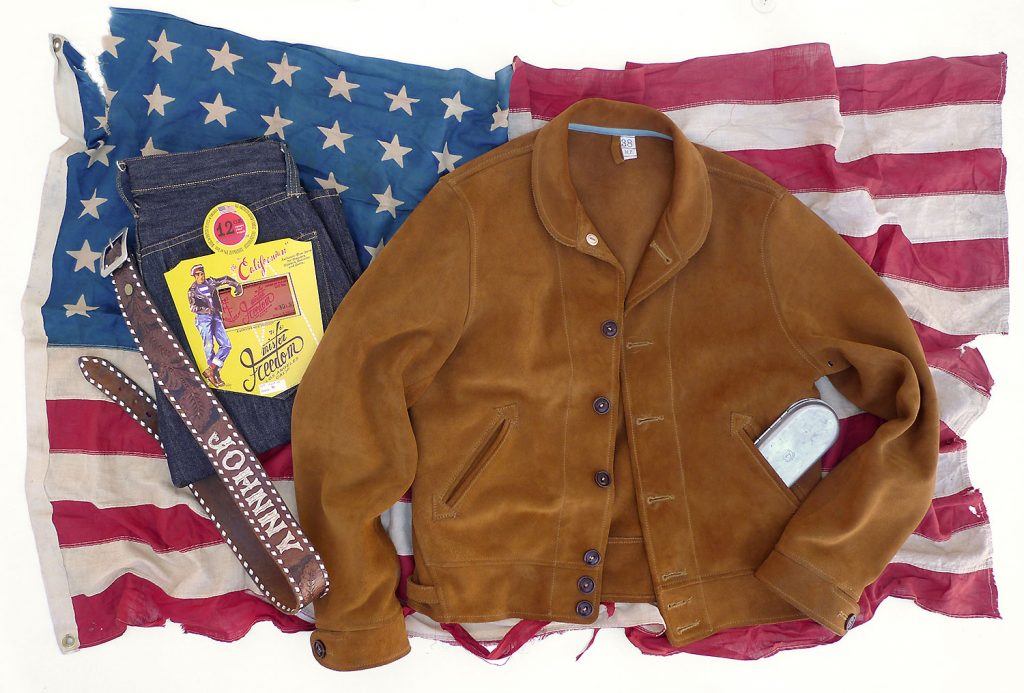

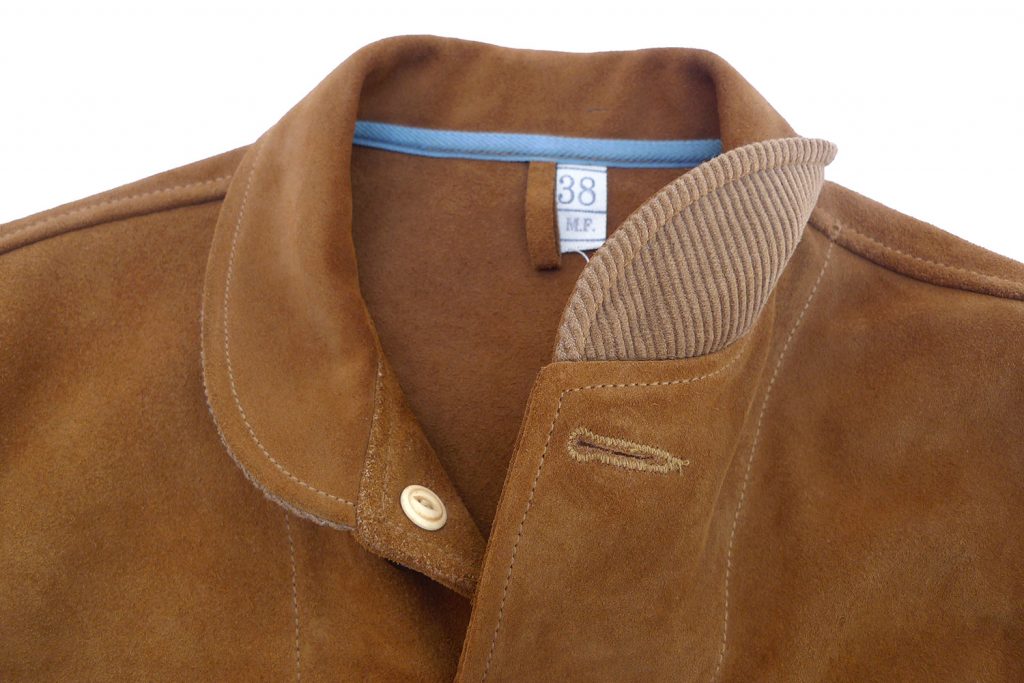
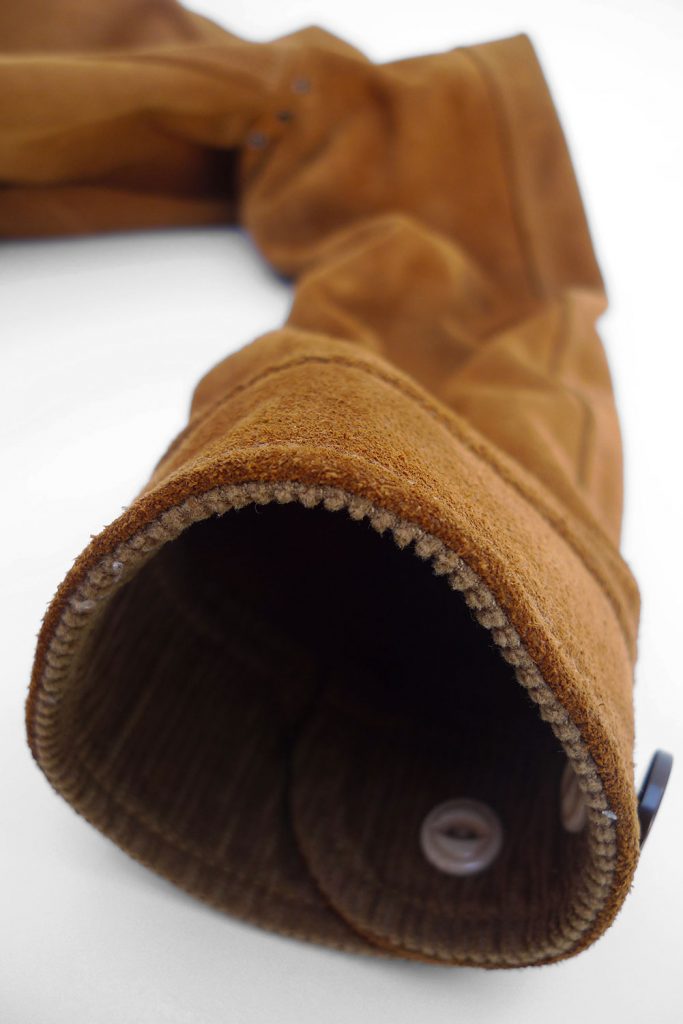
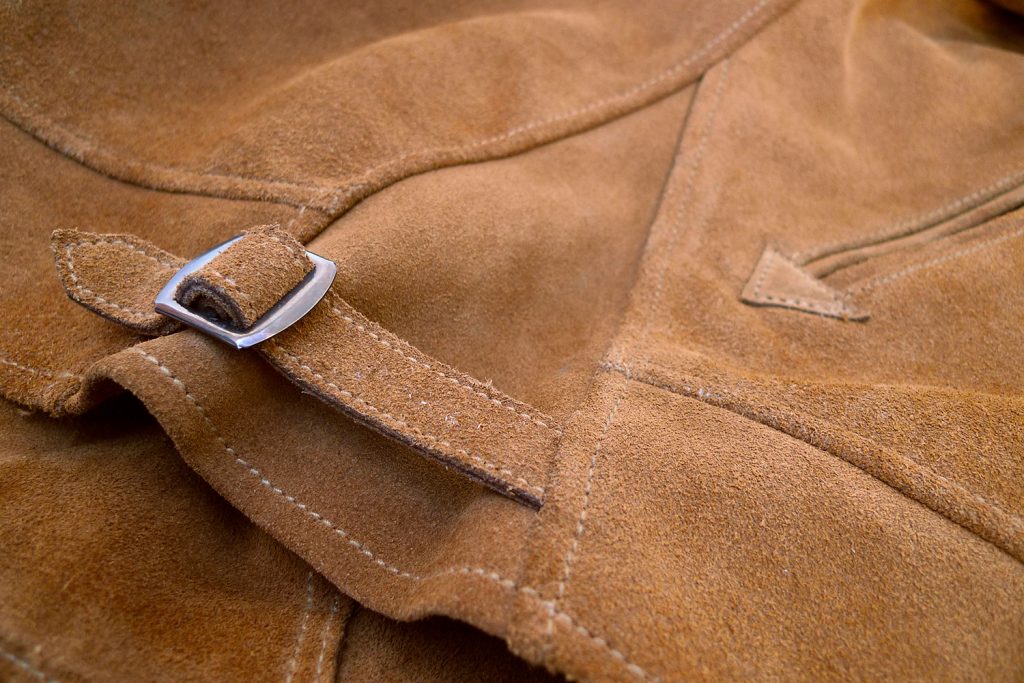
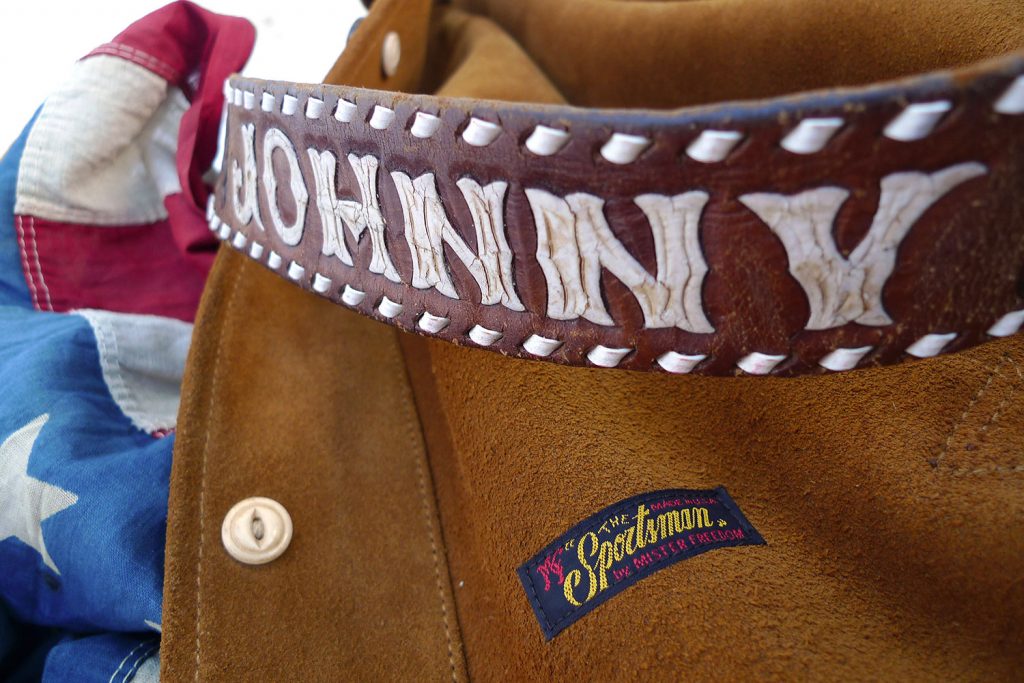
 McQueen being McQueen, 1961 (photo Larry Barbier Jr., courtesy of Getty Images) Mister Freedom® “JOHNNY” Campus jacket, cognac suede cattlehide.
Fall 2018 mfsc Sportsman catalog.
Made in USA.
Our popular MF® Campus pattern is back this Fall, this time in a vibrant suede cow-split leather.
For those who wonder, the name is a quaint reference to the 1991 flick “Johnny Suede”, which I watched some twenty-five years ago, and can’t remember the first thing about, besides the catchy title and Brad Pitt’s big hair.
While out shopping for hides from local suppliers, we selected this particular leather not just for its convincing vintage orange-brown color, a rich cognac tone reminiscent of classic 40’s-50’s suede sportswear jackets, but also because of its durable quality feel, as this is a leather grade used to make western riding chaps. For those eagerly awaiting Mister Freedom® leather chaps, the wait is not yet over.
As its veg-tan cowhide Campus predecessor, initially introduced in 2013 and still produced today in the USA, the MF® “JOHNNY” is unlined. Not a way to save on lining fabric, but rather a nod to unlined “Cossack” leather sports coat models popular in the 1930’s, and a real challenge construction-wise when striving to keep clean seams inside & out.
If the Veg-tan cowhide MF® Campus really takes on a new dimension and beautifies over time (according to the owner’s activity, leather expertise, frequency of wear, conditioning choices and patina preference), the JOHNNY is good-to-go from the get-go.
We do not recommend any initial special spraying or conditioning to make the garment weather-proof or stain-repellent. We have not tested anything really convincing on suede, most treatments will result in an irreversible darkening of the suede leather, and shoe products should definitely not be used on a sport jacket… The old standard practice of dubbing roughout service boots in the military (see tips from our friend Mosquito_Boat) doesn’t apply here.
We believe that our “JOHNNY” Campus has its own dress-up feel, and will benefit from being kept ‘clean’ to age gracefully. The desirable rugged attitude of its Veg-Tan cowhide counterpart properly-worn and conditioned (see the amazing results on Vintage_Engineer_Boots‘ own Campus jacket, with the whole process detailed here) may not work with this suede leather release.
We might be proven wrong and come across a beat-up “JOHNNY” specimen with killer natural patina in a few years (keep an eye on the ultra-talented artist Mark Maggiori‘s IG), but until then, understand that it’s the nature of a casual suede leather sport jacket to be vulnerable to the elements, and Ketchup®. Please wear and feast accordingly.
-
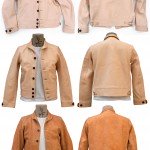
-
The rugged MF® Veg-Tan Campus jacket initially released in 2013.
-
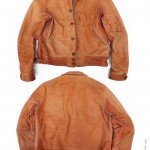
-
Perso Campus jacket, after 1.5 year of intermittent wear
The MF® “JOHNNY” Campus in suede cattlehide is designed and made in California by Mister Freedom®.
SPECS:
PATTERN: An original pattern inspired by 1930’s sportswear type lightweight and unlined leather jackets.
LEATHER: Durable and supple suede cattlehide with a soft nap, aka cow-split leather, a grade used to make western riding chaps. Cognac color.
DETAILS:
* 1930’s silhouette
* One piece back
* Fully unlined, clean seams inside & out.
* Cotton corduroy collar and wrist cuff facing
* Slash pockets with arrowhead-shaped edges.
* Side gussets with adjustable side straps (NOS metal slide buckles)
* Keyhole button holes.
* Brown ‘Cat-Eyes’ corozo wood buttons (aka ivory nut), backed by contrasting ivory-color corozo support buttons.
* Underarm venting eyelets
* Mister Freedom® ‘The Sportsman’ woven label behind the slash pocket, right front panel.
* High stitch-count, sturdy poly-cotton thread stitching.
* Made in California, USA.
SIZING/FIT:
The MF® “JOHNNY” Campus Jacket does not require any type of pre-treatment or conditioning and is ready to wear as-is. This garment is cut quite slim but is considered true-to-size.
I wear a slim-fitting size 38 in the “JOHNNY” Campus Jacket, my usual size in mfsc jackets. Keep in mind that we are referring to a classic old-school type fit, not a contemporary streetwear silhouette.
Please refer to approximate measurement in chart below.
CHART
CARE:
This is quite a delicate jacket, not intended to be worn while working in the field but rather as a dress-up garment.
It does not require any type of pre-treatment and is ready to wear as-is. Cleaning should be left-up to your local professional leather cleaning environmentally-friendly facility.
DISCLAIMER: Due to the unlined quality of this jacket, some staining of a garment worn under or over might occur. Please consider that color transfer on a light color shirt might be challenging to remove with regular laundry methods.
Available sizes:
36 (Small)
38 (Medium)
40 (Large)
42 (XLarge)
44 (XXLarge)
Available from www.misterfreedom.com , from our funky brick and mortar store in Hollywood, CA., and from a few selected fine boutiques around the World.
Please call 323-653-2014 or email sales@misterfreedom.com with any questions not answered above. And no, it doesn’t come in black.
Thank you for your support.
Christophe Loiron
Mister Freedom®
©2018

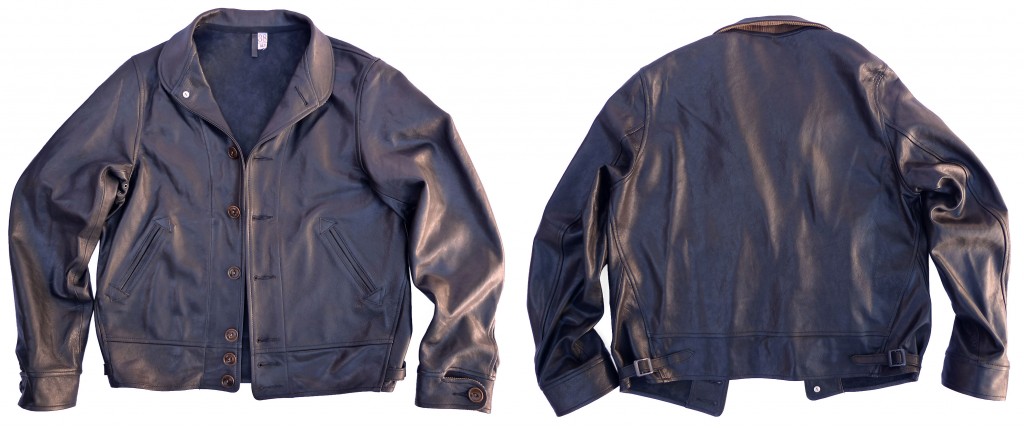
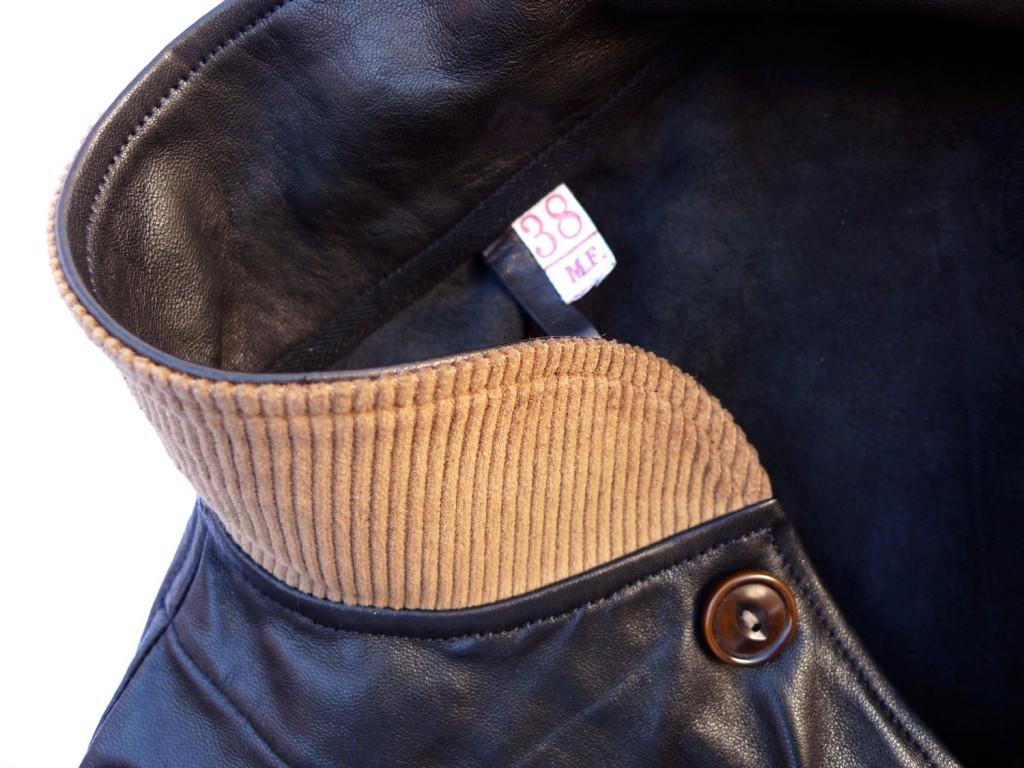
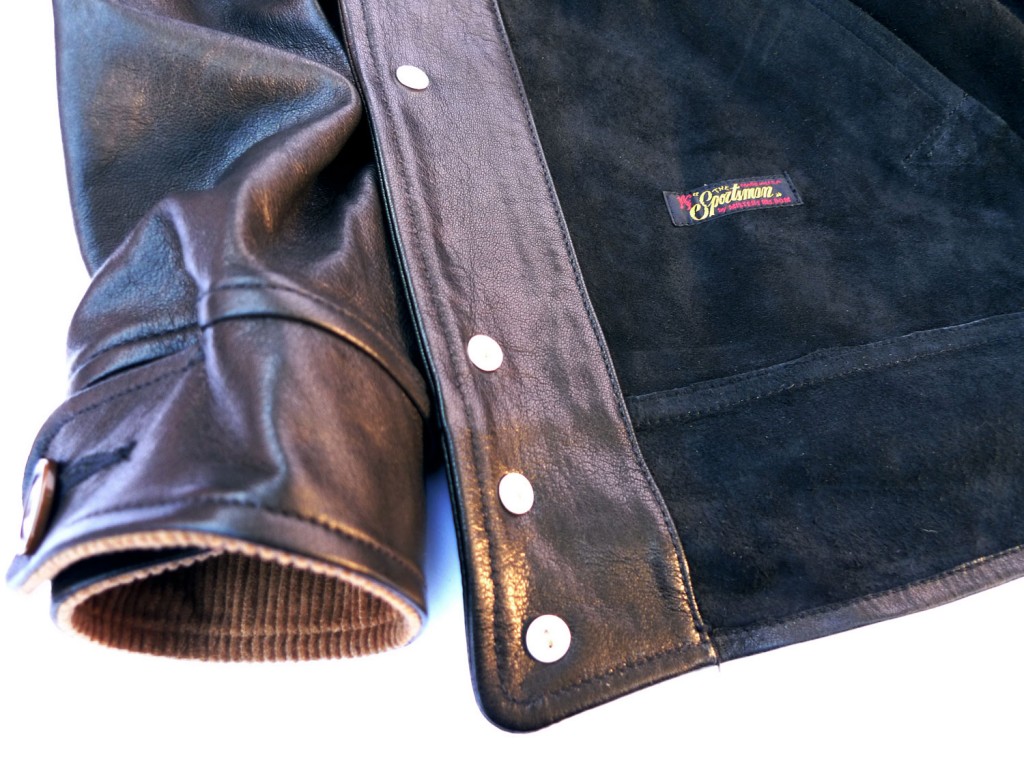
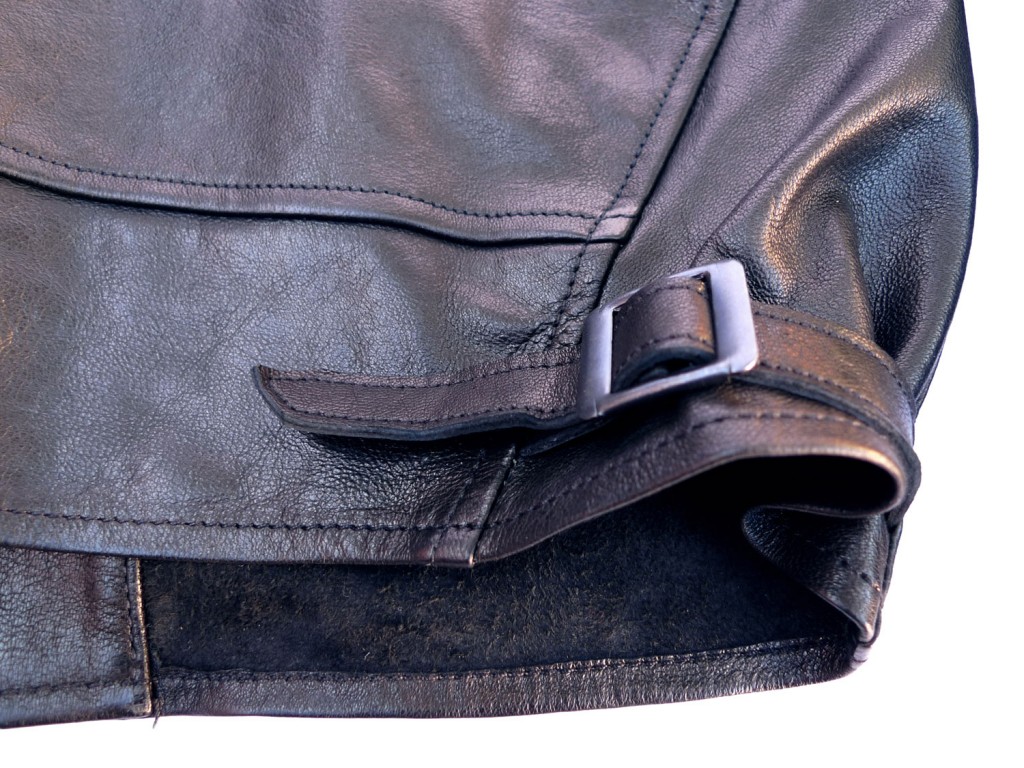
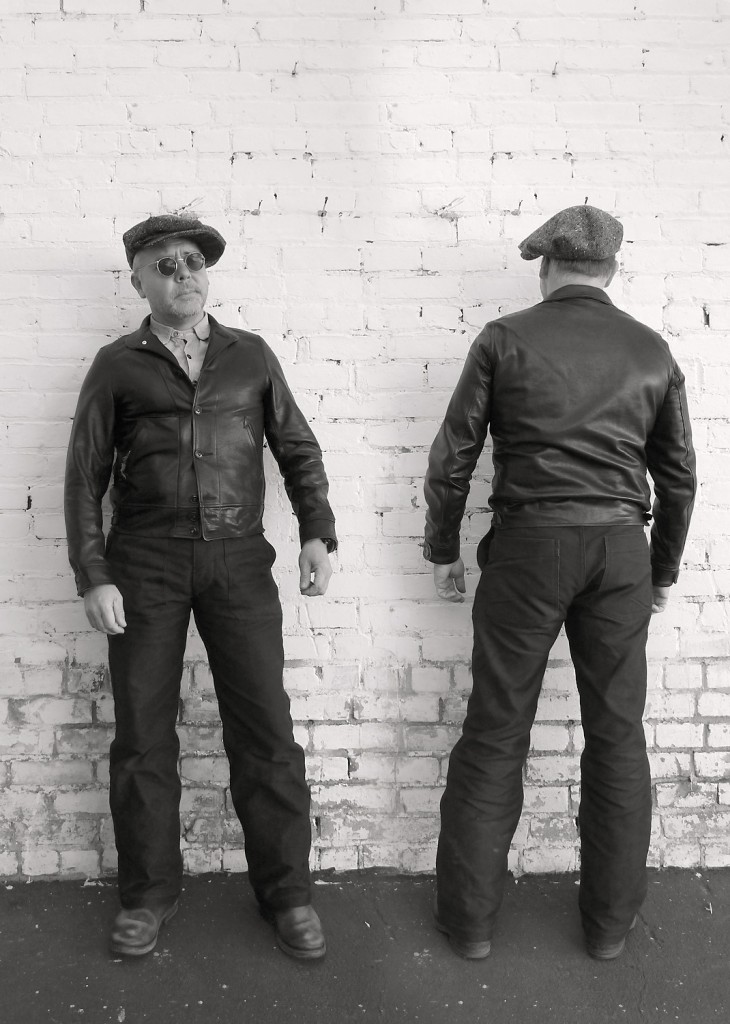 Pappy proudly striking a pose in his brand new Black Lamb Campus jacket. We believe he’s ready for the draft horse test.
Mister Freedom® Black “CAMPUS” Jacket, Italian veg-tanned Lamb edition
‘The Sportsman’ Fall 2014
That’s right jack.
It’s back.
It’s black.
And I don’t mean zombie-consumerism Friday, with deals you can’t refuse on things you won’t use.
I’m talking new addition to the Sportsman catalog. Like a new version of the MF® Campus Jacket we originally introduced in 2013.
In this instant-gratification World, where mass producing soft factory-distressed garments is the norm and the money-making ticket for the Garment Industry majors, releasing an unlined pink-colored cowhide jacket, as we did in the Fall of 2013, can be seen as an unwise move. In the “these guys are not well” kind of a way…
But thanks to the good sports who decided to take the plunge and play the DIY game, we survived. And, a year later, there are some mighty fine examples of worn-in Campus jackets out there.
We were rewarded by all the cool evolution shots, every patient new owner molding his Campus to his own liking, for some breaking it in for the next generation.
One way to do it was expertly documented on the Vintage Engineer Boots website by our friend USMC MSgt John V.
Whether hands-on or via social media photos, witnessing this fun natural patina process might have hopefully convinced a few skeptical individuals that the ‘worn look’ will come… naturally. Our Campus jacket went from a ‘raw’ light pink to warm shades of orange, with basically sun exposure and wear. Nothing revolutionary for you salty bunch, but an apparent novelty for some who hold factory-distressed clothes as the norm, because they are ‘comfortable’ straight off the rack…
My apologies to the choir for the broken record.
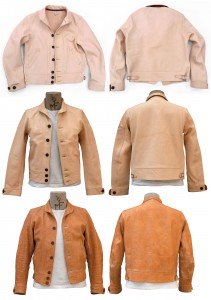 Early evolution of a Campus jacket, 2013 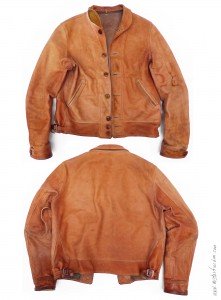 Perso Campus jacket, 1.5 year of intermittent wear Then, in 2014, this happened…
As I was sourcing out leather one day, trying to discern Sonny Fisher’s ’56 “Pink and Black” from the engine rattle, I came across a stack of wrapped bundles of black leather sitting on top of a metal shelving unit, in a wholesaler’s warehouse. Inside the craft paper, small hides of a supple and delicate leather with somewhat of a glove leather touch had been gathering dust for years. This was ordered from an Italian tannery and was never paid for, I gathered…
Long story short, this was a New Old Stock lot of genuine vegetable-tanned lamb hides from Italy (I found some remnants of paperwork in the rolled skins).
Although a definite departure from the rugged look of a worn cowhide Campus jacket, I felt that a black Italian lamb Campus would not be too shabby of an addition to the Mister Freedom® Sportsman catalog. Next thing I remember, I was driving off with my lamb loot.
The USA manufacturing went as smooth as the first time around…
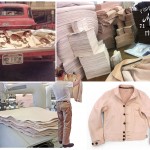 The first time around… For extra fun and because we had way too much time on our hands this summer, the originally solid dark brown corozo buttons we selected for the project were left in the sun for several weeks. This gave ‘life’ to the wood grain and veins, making each button unique, and puzzling the neighbors in the process. Yes, we laid each button flat in several trays, one by one, then put the trays on the roof for a tan. We then sat down and stared for over a month. Don’t worry, we took turns.
Now, if you‘re very bored one day, check the back side of a button, for an idea of its original color.
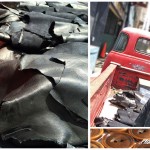 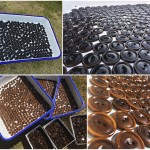
The style of our Campus jacket, inspired by a “Cossack” type cut popular in the 1930’s, has been discussed in the original post and remains the same for this black lamb issue.
This time however, DO NOT immerse this jacket in water! Don’t even think about it…
The black lamb Campus is ready to go, just requires to be worn as-is, without any pre-treatment or efforts.
This version is intended as an elegant 1930’s style jacket, dressy sportswear if you will. These veg-tanned lamb hides are delicate and will scuff easily. Do not rub against brick walls or drag this jacket behind your car, like this maniac…
This is not a workwear-type coat meant for field work and rugged treatment, including storing nails in the pockets. You wear this on a date. Or to get a date, when cargo shorts don’t cut it.
Bottom line, should both arms of our Black Lamb Campus get tied to two draft horses pulling in opposite directions, we guarantee the jacket will rip in half.
The Campus Jacket was designed and manufactured in California, USA, by Mister Freedom®, with the help of Sugar Cane Co.
SPECS:
PATTERN: An original pattern inspired by 1930’s sportswear type lightweight leather jackets.
LEATHER: Genuine Italian vegetable tanned lamb leather, exclusive to the USA production. The leather is BLACK.
DETAILS:
* 1930’s silhouette
* One piece back
* Fully unlined, clean seams.
* Cotton corduroy collar and wrist cuff facing
* Slash pockets with arrowhead-shaped edges.
* Side gussets with adjustable side straps (NOS metal slide buckles)
* Keyhole button holes.
* Sun-tanned brown ‘Cat Eyes’ corrozo wood buttons (aka ivory nut), backed by 1920’s NOS French antique glass buttons (some jackets will have black, some will have iridescent white-colored back-buttons).
* Underarm venting eyelets
* Mister Freedom® ‘The Sportsman’ woven label behind the slash pocket, right front panel.
* High stitch-count, sturdy poly-cotton thread stitching.
* Made in California, USA.
CARE/SIZING:
This is quite a delicate jacket, not intended to be worn while working in the field but rather as a dress-up garment.
It does not require any type of pre-treatment and is ready to wear as-is.
After a few years of normal use, professional care or conditioning might be considered and left to a veg-tanned leather specialist. Again, DO NOT immerse in water.
The cut of the Campus is quite snug, depending of course on your own built. I wear a snug 38, my usual size in MF® jackets, with a simple Tshirt or light shirt underneath.
Like its cowhide predecessor, this black lamb model is true to size. It is not anticipated that the lamb leather will stretch/’shrink’ with normal wear.
Please refer to sizing chart for approx measurements, identical to our 2013 natural cowhide Campus jacket.
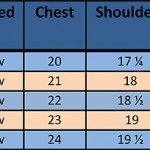
Sizes
36 (Small)
38 (Medium)
40 (Large)
42 (XLarge)
44 (XXLarge)
Retail $949.95
Soon available on www.misterfreedom.com.
Please call 323-653-2014 or email sales@misterfreedom.com with any questions not answered above.
As always, thank you for your support.
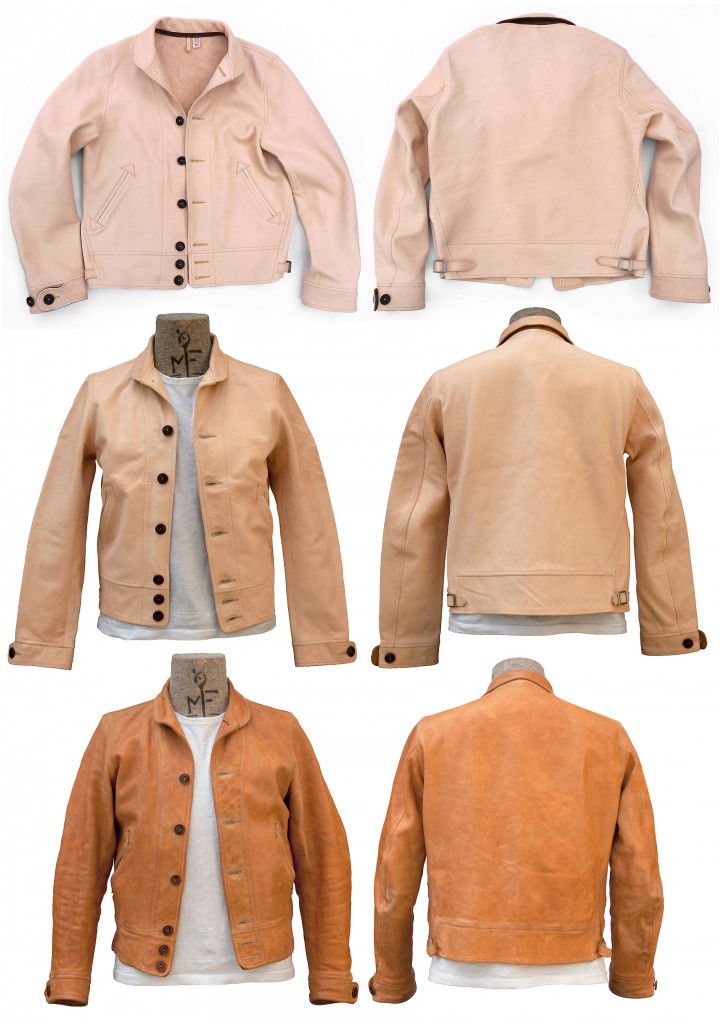
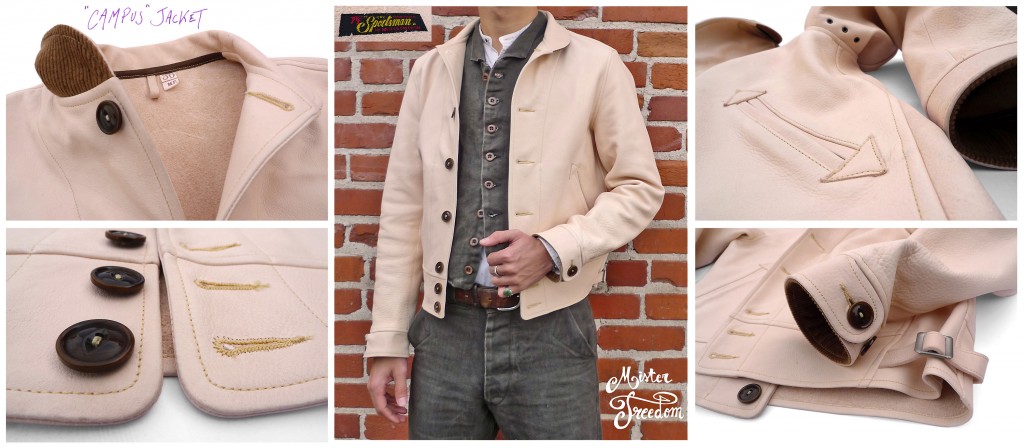
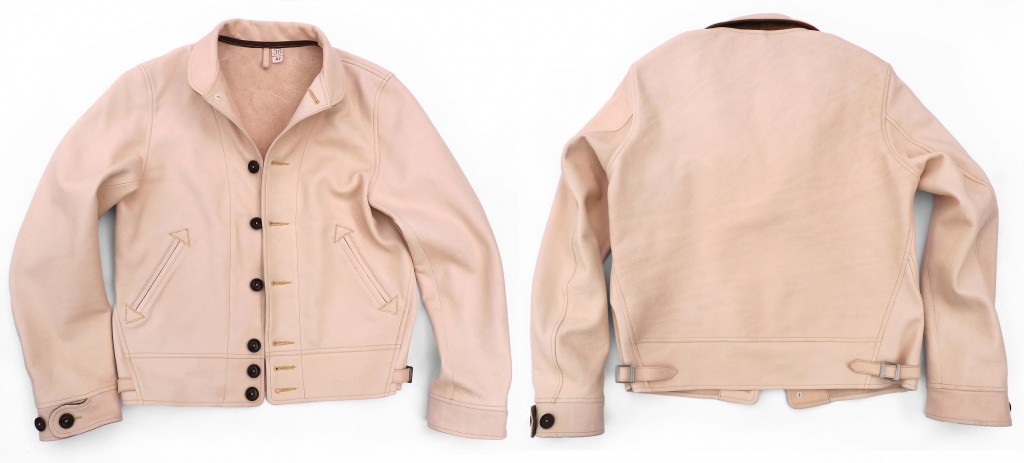
Mister Freedom® “CAMPUS” Jacket
‘The Sportsman’ Made in USA, Fall 2013
Closely following the career of Justin Bieber, I have decided to make a 1930’s style leather jacket of absolute no interest to him.
If we usually do not claim to have come up with the perfect garment, this time… is no exception.
However, I’ll still share the American saga that started sometime in early 2012, to end a few weeks short of Christmas 2013.
Thanks to the hard work of many, here is our “CAMPUS” jacket today, an addition to our staple Mister Freedom® ‘The Sportsman’ catalog.
This jacket comes somewhat as a Do-It-Yourself kit. Not that what you’re getting is a cow with thread and needle, along with instructions in 12 languages starting with “Carefully insert A, you fun have is go now. Yes? Welcome” on page 1. But rather in the sense that our CAMPUS leather jacket is a blank canvas for you to colorize.
These days, with no shortage of disposable mass produced goods crowding shelves and virtual stores, well orchestrated impulse buys and tantalizing ad campaigns stimulating consumerism, it is easy to forget that clothes are actually made by real people, use resources to manufacture, and are the result of a long chain of events. I believe clothes should not become widgets and end up in landfills…
By acknowledging the work and efforts that go into manufacturing a garment, by being aware of the challenges, one should naturally acquire a certain respect for things man-made.
We hope to send this simple message by creating a connection with this DIY garment and its owner.
To do so, we opted for a leather with an untreated natural looking finish, somewhat of a ‘raw’ state that will start to age and become one with the wearer the moment the garment is removed from its packaging, namely a cool re-usable selvedge denim printed bag.
About style:
Our CAMPUS is a Mister Freedom® interpretation of traditional 1930’s ‘Cossack’ type jackets. Originally, the term ‘Cossack’ might have referred to the versatile collar shape that allowed to be flipped up to a military style Nehru collar… For all I know, it might as well be referring to a Mrs. Cossack, fierce week-end seamstress, who first came up with a short unlined leather jacket with a round collar for her stylish hubby… As always, don’t quote me on anything.
What I do know is why we called our jacket the “CAMPUS”: flipping through a 1933 Pasadena Junior College year book entitled ‘Campus’, I noticed that that style of jacket was on many of the students’ backs. Some jackets appeared to be suede, some full-grain leather, most with A-1 type patch pockets… but all with the consistent typical ‘Cossack’ style, short with round collar. Times when Charles Lindbergh was hip. And Jacques Cousteau a hipster.
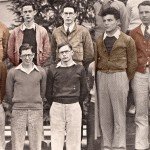 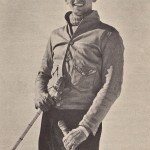
I remember owning a similar jacket in the early 1990’s. Found in a thrift store for a few bucks, I remember it having a beautiful patina but fitting a tight in the arms. So I, of course, immediately thought of cutting the sleeves off… I am not sure where the body is today, but I know I kept the sleeves, having recently found them in a pile of leather scraps at work.
How sane it is for one to hold on to old leather scraps for 23 years is unsure, but chopping the sleeves of that gem was a real lifetime achievement…
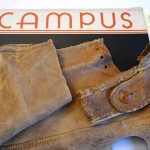 Campus 1933 Yearbook, vintage Cossack scraps So, 23 years after, I can only try to redeem myself with a leather jacket that can be passed on to the next generation. In some 60 years, when someone stumbles on a beat-up vintage Mister Freedom® ‘CAMPUS’ and has an urge to turn it into a vest, we will have gone full circle…
About construction:
Our choice of keeping the CAMPUS unlined is a nod to many older ‘Cossack’ type jacket. This sounds today like a ‘cheaper’ alternative to a full lining, but is actually a real challenge for one concerned with both outside and inside appearance. Inside exposed seams are often very funky in the vintage samples I have seen. With the CAMPUS, we thrived to keep it clean in and out. And anyone who works with leather knows that you do not get a second chance…
We also opted for poly-cotton thread this time, having seen too many vintage leather jackets with busted out seams.
About the leather:
I opted for a light weight vegetable tanned full grain milled cow hide, untreated natural finish, origin USA. Each hide was carefully selected by hand, many rejected, a fun process. Within the same grade, there were no two alike, resulting in each CAMPUS jacket having its own character, specificity, feel and natural ‘imperfections’.
Extremely light sensitive, pretty much like the (usually) unexposed parts of your own skin, this natural hide will start ‘tanning’ when exposed to the sunlight.
Originally of a white pinkish color, this leather will turn quite orange when worn/left in the sun for a few days. THIS IS NORMAL, and expected.
Unless you are Batman, the CAMPUS will change color as you wear it outside. Expect stains, water marks, natural grease, scratches, patina and creases if you are planning on taking it out of the closet where it doesn’t belong. All this adds to the character of a leather garment, and is the reason why they are referred to as ‘second skin’.
We are offering the Campus in pure new condition, not ‘factory distressed’. The jacket’s journey will be yours and each nick a memory. The evolution photo with the three stages is for reference only, results will depend on how you wear your Campus, how often and your type of activities.
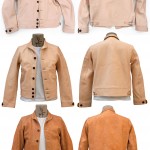 Evolution will depend on use 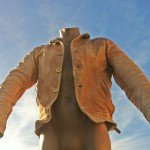 Early prototype sun bathing I once had in my hands a NOS 1930’s ‘Cossack’ leather jacket, original tags and all, featuring a printed paper sticker affixed to the flesh side of the hide. The sticker claimed the garment was “HAND WASHABLE with Castile Soap”.
Now. We have experienced soaking the CAMPUS in cold water, spin dry, line dry, worn briefly to shape, as demonstrated in this silly cartoon.
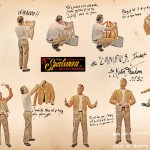 What NOT to do, step by step However, results have varied greatly and we DO NOT RECOMMEND IT. Some of the hides will shrink and/or stiffen more than others. So there is a chance of ending up with a leather brick two sizes too small… Should you wish to proceed with dipping your jacket in water, you are on your own…
It is much safer to wear the jacket and let natural patina happen over time.
For the adventurous type however, putting the CAMPUS jacket on a bust form outside and letting it tan for a while can have interesting results. Avoid large seagull populated areas. Also make sure to periodically move it around so that the sun tan looks natural, avoiding crisp lines. Anyone who ever woke up on a beach at noon will understand.
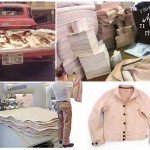 Just a few of the stages… Anyways, here is the promised saga:
After the hides were selected, bought and dropped at the factory, the cutting began.
Then the skiving (for less bulky seams.)
Then the sewing…
The unfinished jacket were taken to yet another place to have keyhole type button holes added, instead of the more modern looking bound button hole construction.
The ultimate trip was to MF® atelier (a fancy word for our in-store sweat shop) where the buttons were patiently hand stitched, one by one.
Besides a long delay from the start due to difficulties sourcing all the required hides, I am happy – and relieved – to say that everything else went as planned.
If at any stage something could have gone very wrong, everyone involved did an amazing job to prevent FUBAR status.
Cheers!
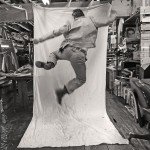 The MF soft shoe
And thus ends the saga of our CAMPUS Jacket…
Designed by Mister Freedom® and made in California, US of A.
SPECS:
PATTERN: An original pattern inspired by a Mrs. Cossack, and 1930’s sportswear type light leather jackets.
LEATHER: Vegetable tanned leather, full grain cow hide, milled and supple, natural finish and color, about 2-3 Oz weight, origin USA
DETAILS:
* 1930’s silhouette
* One piece back
* Fully unlined, clean seams.
* Cotton corduroy collar and wrist cuff facing
* Slash pockets with arrow stops.
* Side gussets with adjustable side straps (NOS metal slide buckles)
* Keyhole button holes.
* Corrozo ‘Cat Eyes’ wood buttons (aka ivory nut), backed by NOS French 1920’s glass buttons.
* Underarm venting eyelets
* Mister Freedom® ‘The Sportsman’ woven label behind the slash pocket, right front panel.
* High stitch-count, sturdy poly-cotton thread stitching.
* Made in California, USA with American cowhides.
SIZING:
Because of its weight on the light side for a leather jacket, I wanted a slim and quite snug fit, reminiscent of the original 1930’s silhouettes. This leather jacket is easily wearable during California summer evenings, with a light shirt or T-shirt. Besides the easy blue jeans/Ts, I like the more elegant white shirt/tie look with it as well.
During winter, the CAMPUS can be layered under an heavier outwear jacket, an old school down vest etc…
I am usually a 38 in mfsc jackets and I am a 38 in the CAMPUS, with room for a lightweight shirt underneath.
Tom is wearing a 36 on the photos, his usual size in MF® jackets. Tom, however, does not eat calzones.
Please refer to sizing chart for approximate measurements.

CARE:
We recommend you leave you CAMPUS as-is and just wear it.
Because of its original light natural color that will darken over time, it is prone to get soiled, water marked etc… This is part of the tough life of a leather jacket, your second skin.
Just for info, Dr. Bronner’s Castile soap is used by some pro tack shops to clean leather, at your own risk. Pecard also offers quality leather dressing.
Please be aware that almost anything applied to light colored leather will alter its color.
What ‘works’ on boots is not what you put on a saddle (if you want to stay on it), and definitely not made for clothing.
Seek the help of a professional leather cleaner should staining occur that you cannot live with.
Note that some shedding of the leather ‘flesh’ side may occur for a while and leave (brush-able) flecks visible on dark shirts or waistcoats.
I have tested the corduroy ‘El Americano’ waistcoat with the Campus… once. This shedding should settle after a certain period of wearing the jacket.
Available NATURAL/‘raw’
Sizes
36 (Small)
38 (Medium)
40 (Large)
42 (XLarge)
44 (XXLarge)
Retail $949.95
Available on www.misterfreedom.com , at our brick and mortar in Hollywood, CA., and at a few selected fine boutiques around the World.
Please call 323-653-2014 or email sales@misterfreedom.com with any questions not answered above.
Thank you again for your support 😉
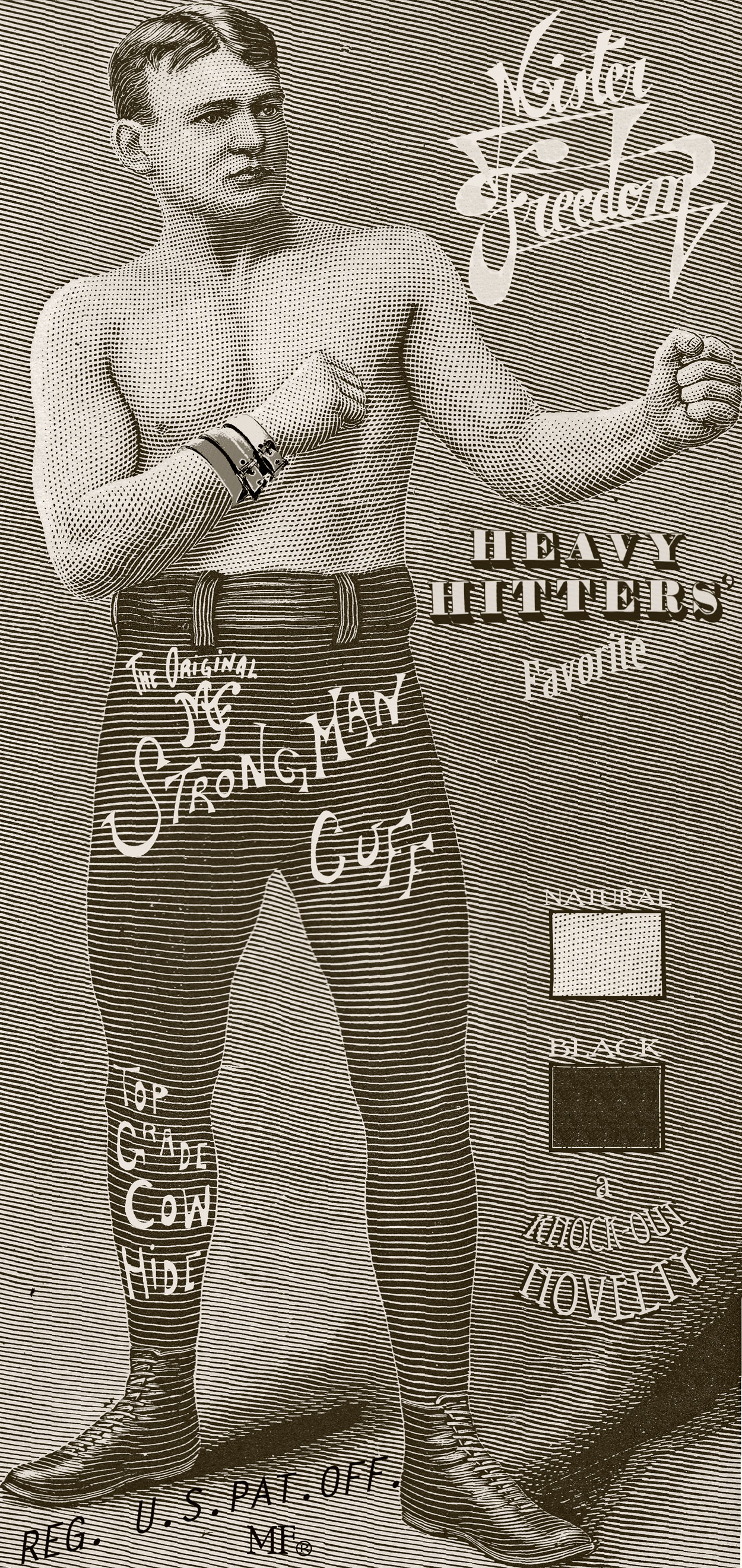
Mister Freedom® original cowhide leather “STRONGMAN CUFF”
Inspired by turn of the Century carnival imagery, brawlers, loading dock workers and drudges, here is our take on what served the purpose of keeping your wrist protected while heavy lifting. Those cuffs were often matched with a kidney belt.
In the style of early traveling dentists’ advertising claims, besides instantly winning or earning you “fame, hearts, elections, bouts and the lottery“, they should make lifting that mouse off that pad a breeze 😉
We used high grade American veg-tan natural cowhide, equestrian quality NOS alloy steel roller buckles, hand set brass rivets, and an original MF® die cut one piece pattern.
The debossed MF® branding is concealed under the wrap around strap and doesn’t show when worn. Three holes on the double straps allow adjustment to your own wrist size. They might feel a bit tight and stiff at first, but when worn on a daily basis, the leather slightly stretches and ‘molds’ to your wrist. You will also get a nice natural patina with normal use and rubbing (no problems to wash your hands with it, just remove when sleeping, or in the shower.)
I wear mine with the buckles on the wrist outside, with the double straps on top, but you will figure out what works for you.
There are two veg-tan leather options: NATURAL (untreated) and BLACK (hand surface-dyed, not dipped, aka tea-core).
As with the rest of our products, we do not offer “aged” versions of those cuffs. Be a good sport, we did half the work, you do the rest 😉
Hand made in California, US of A.
Available RAW/untreated.
One size fits most.
Retail: $129.95
Call (323) 653-2014 or email sales@misterfreedom.com to get yours while they last. We ship internationally.
Much obliged for your support.
|













